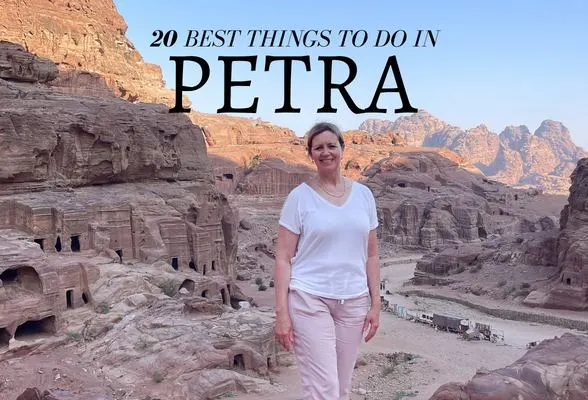The Rose City of Petra in Jordan has enchanted visitors, since the ruins of this ancient Nabataean city were rediscovered by Europeans in the nineteenth century. As Jordan’s top visitor site, it’s one of the highlights of any visit to the country and one that lived up to our expectations. To help you make the most of visiting Petra in Jordan, we’ve put together this travel guide with all our top tips.
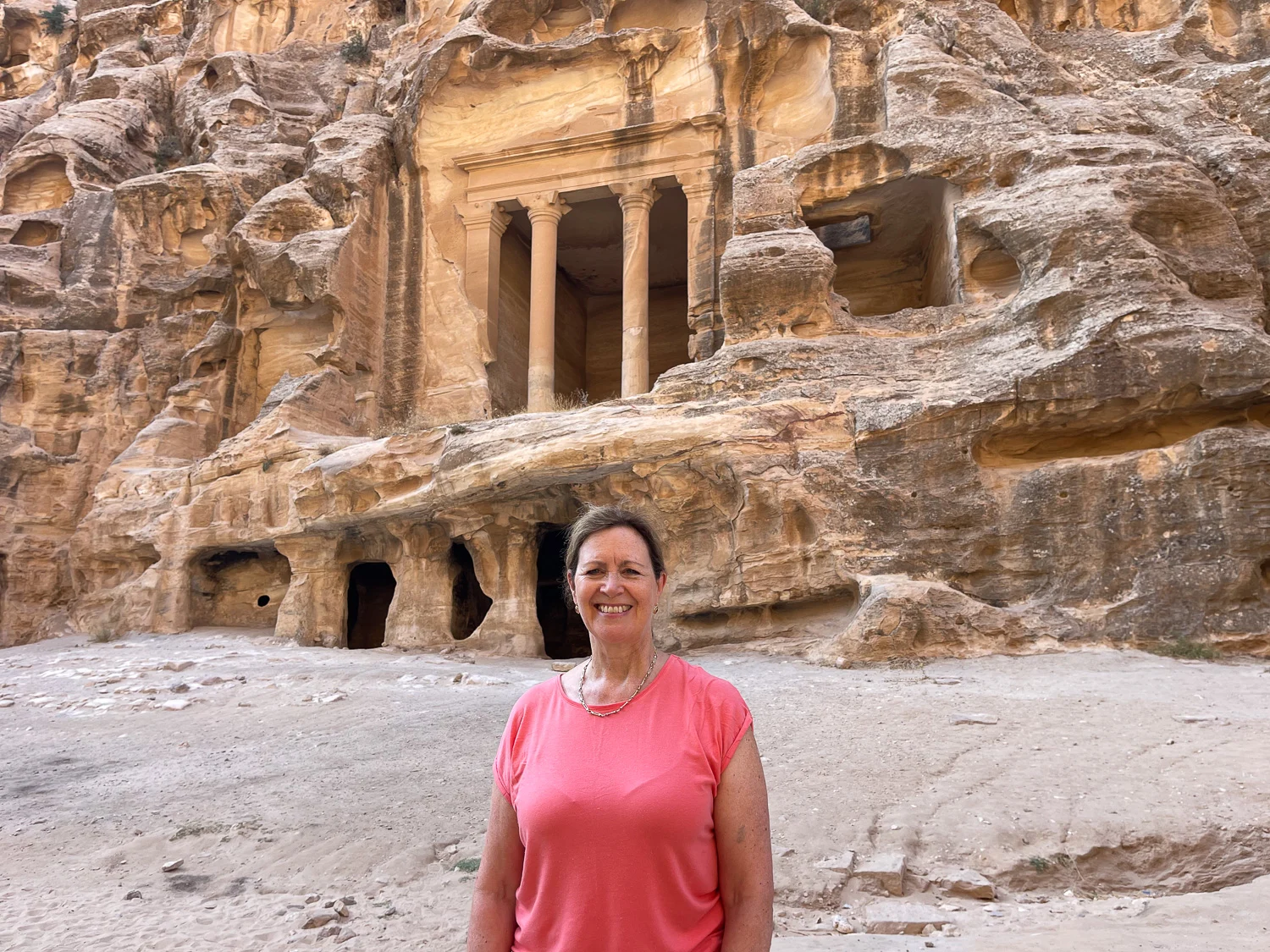
Despite the crowds, ubiquitous souvenir stalls and animal ride sellers, Petra seemed to increase its charms and mysteries the more we explored beyond the Siq and Treasury. But to make the most of your visit you do need to plan ahead for where to stay and how long to come for, as well as the top things to see and other things to look out for.
Our aim in this article is to cover most of the things you need to know before you visit, on arrival and while inside the archaeological site of Petra. Let’s go and discover your inner Indiana Jones!
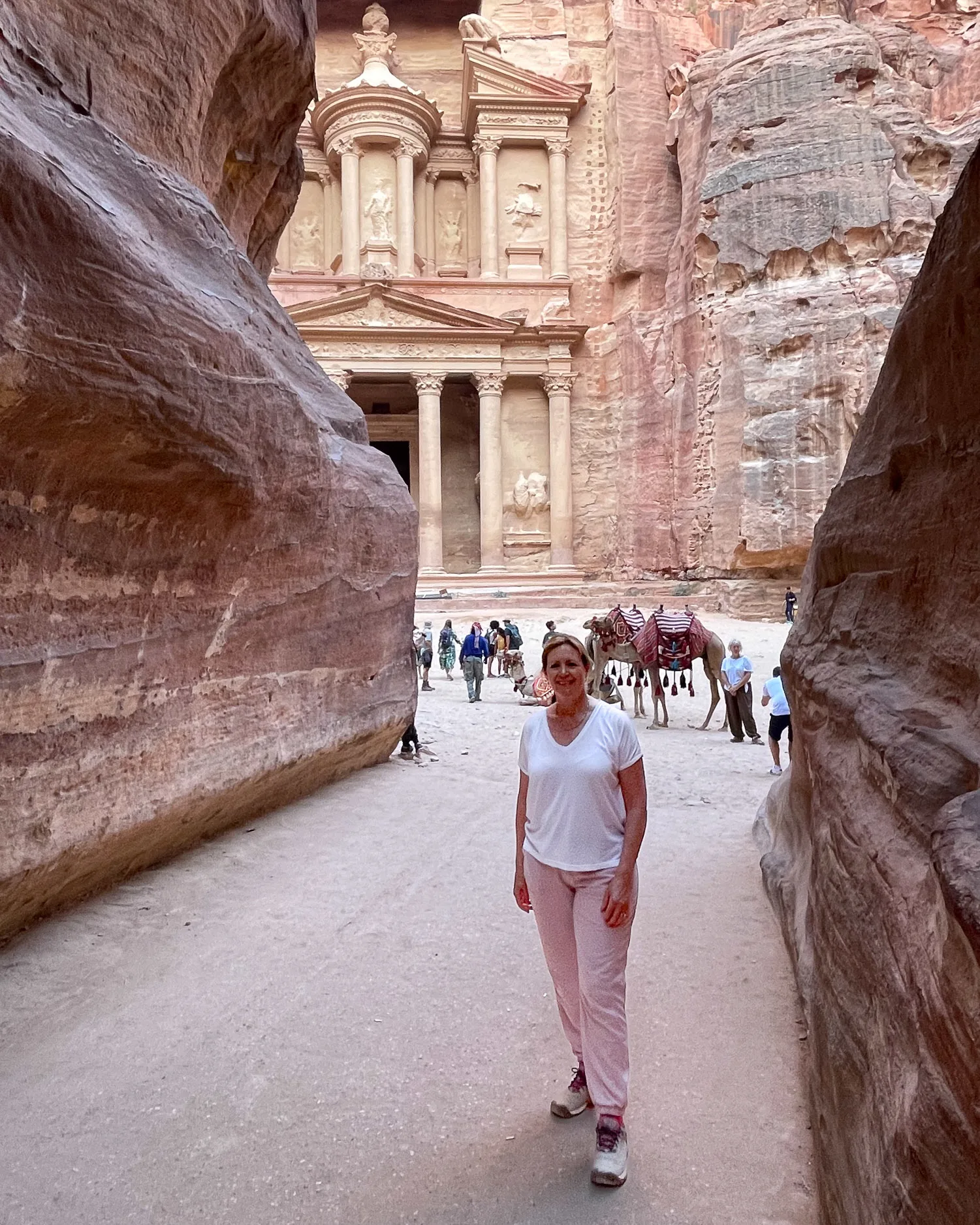
This article may contain affiliate links that provide commission on purchases you make at no extra cost to you. As an Amazon Associate I earn from qualifying purchases.
We also have another article about Petra, that covers the top things to do in Petra in much more detail including our recommended itineraries. Read: 20 best things to do in Petra – plus itinerary ideas
Petra travel guide – tips before you go
In this section you’ll find our tips to help plan your trip, such as accommodation, getting there, tickets and how many days you need to visit Petra.
Where is Petra?
Petra is located in the south west of Jordan, 230 km (3 hrs drive) from the capital of Amman in the north or 130 km (2 hrs drive) from the Red Sea resort of Aqaba to the south.
Most international travellers fly into either Amman or Aqaba, then visit the Petra archaeological site as part of a circular tour of Jordan, visiting Amman, Petra, Wadi Rum, Aqaba and the Dead Sea.
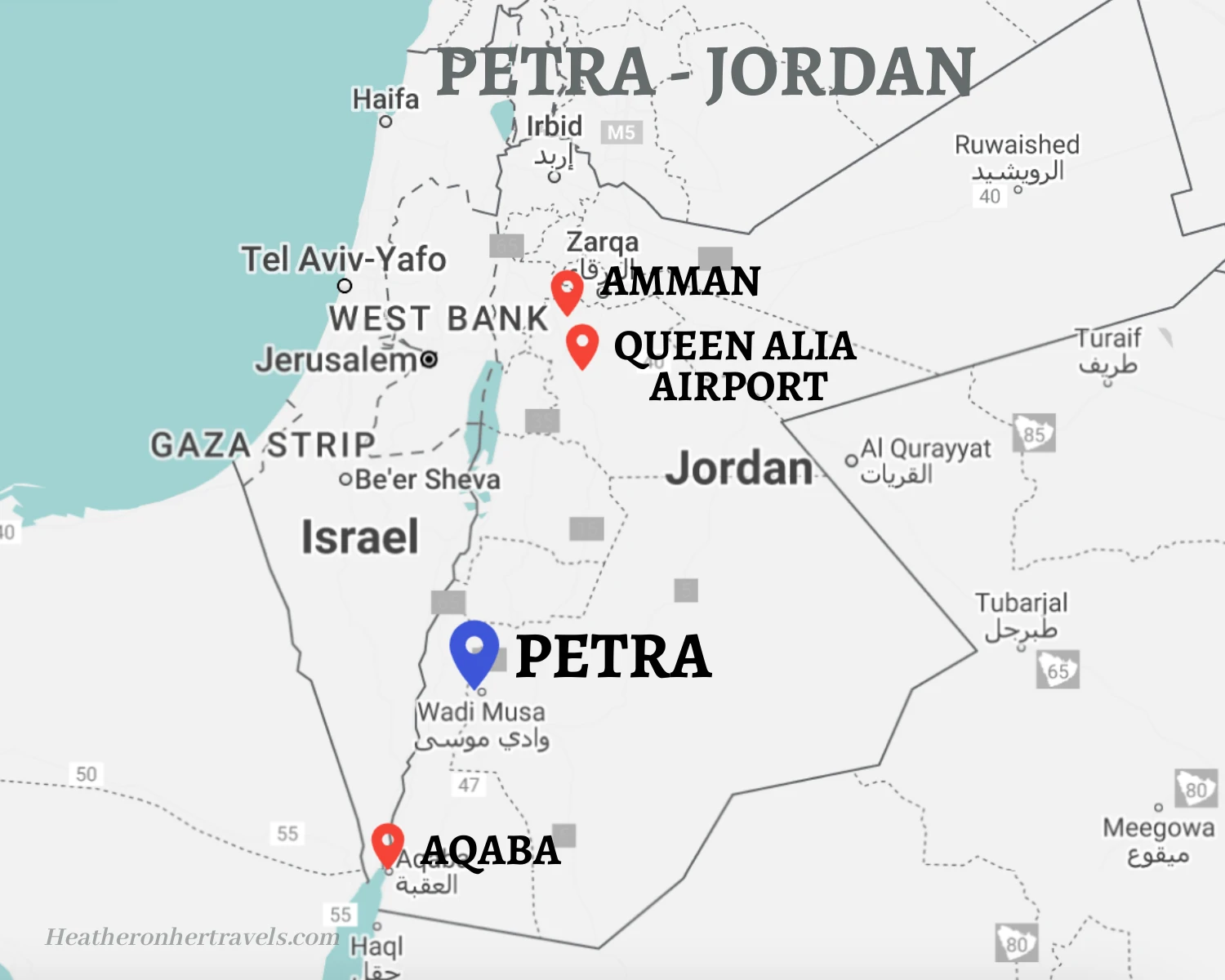
Where to stay in Petra
The town that serves the archaeological site of Petra is Wadi Musa and this is where the majority of visitors stay. When transport to Petra is mentioned, the bus or taxi will actually take you to the town of Wadi Musa.
Wadi Musa is roughly divided into the lower town, which is closest to the Petra entrance and visitor centre, and the upper town which is around 15 minutes walk up the hill.
We would recommend staying in the lower town, since the last thing you want after a long day walking around the huge Petra site is an uphill walk to your hotel. There are a range of hotels, shops and restaurants in the lower town and you’ll be 5-10 minutes walk from the Petra Visitor Centre and entrance.
If you are on a tight budget you may decide to stay in the upper town, since this area offers more choice of budget accommodation. You’ll also find a wider range of restaurants up the hill. There are taxis available outside the Petra Visitor Centre, so you can take one of these between the lower and upper town, if you don’t want to walk.
In the lower town we can recommend the following hotels, with something for all budgets:
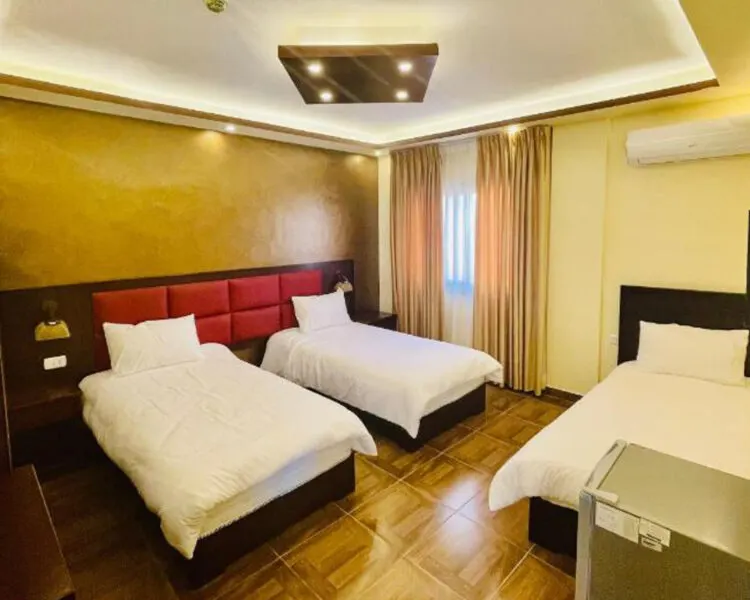
Esperanza Petra – A good budget hotel with rooftop restaurant in the lower town of Wadi Musa (we stayed here)
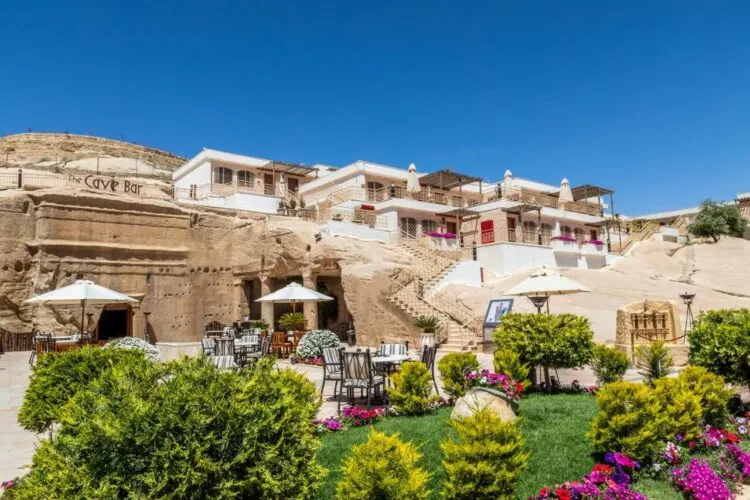
Petra Guest House Hotel – A mid range hotel with famous cave bar located next to the Petra Visitor Centre
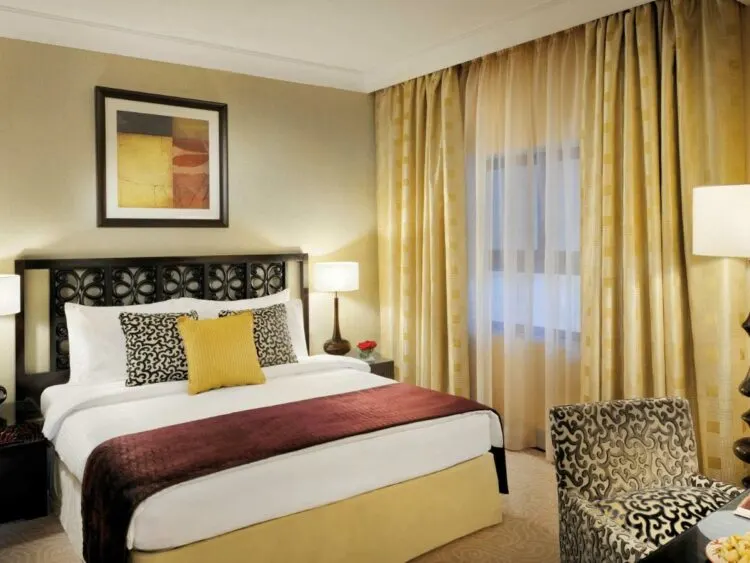
Mövenpick Resort Petra – A luxury hotel with swimming pool that’s opposite the Petra Visitor Centre
How to get to Petra
By Car to Petra
It’s easy to hire a car in Jordan (we managed it!) and use it to organise a self drive trip of the country that includes Petra. If you’re flying into Amman, it’s probably easiest to arrange a hire car from Queen Alia international airport, located just south of Amman.
From the airport, it’s an easy drive south, on the main Route 15 dual carriageway. An alternative road south (there are only two) is the more scenic ‘King’s Highway’ that runs through smaller towns and villages. From Aqaba, you can also easily hire a car and drive north to Petra.
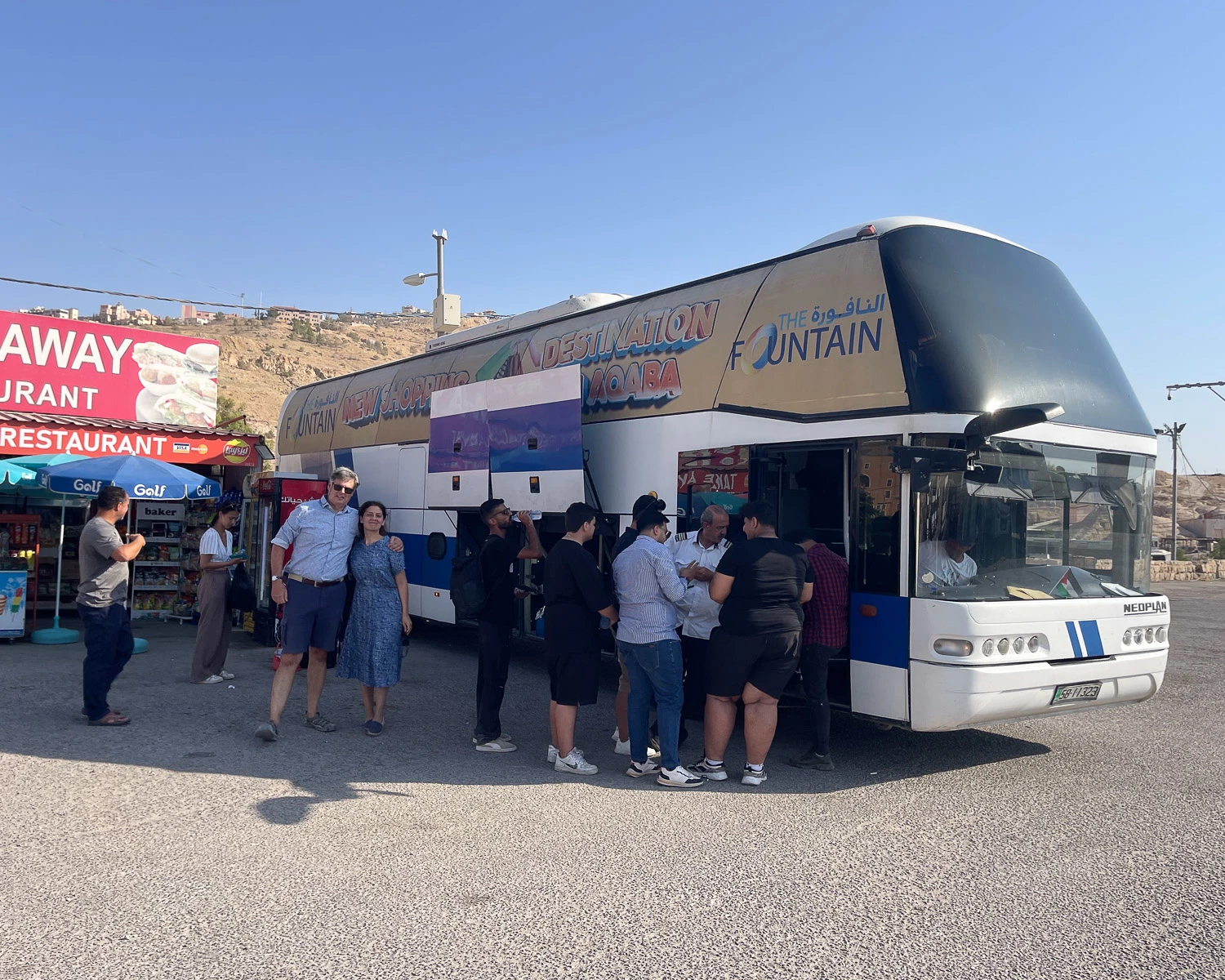
By Bus to Petra
There is one bus a day in each direction between Amman and Petra with JETT.
The bus leaves Amman from Abdali bus station daily at 6.30am and the journey takes around 3 hours. On the return journey the bus leaves Petra at 5pm, from the bus station just above the visitor centre. Cost for a 1 way trip is 10 JD.
If you are coming from Aqaba to Petra the daily bus leaves at 8am and from Petra to Aqaba leaves at 5pm. The journey takes around 3 hours and cost is 15 JD.
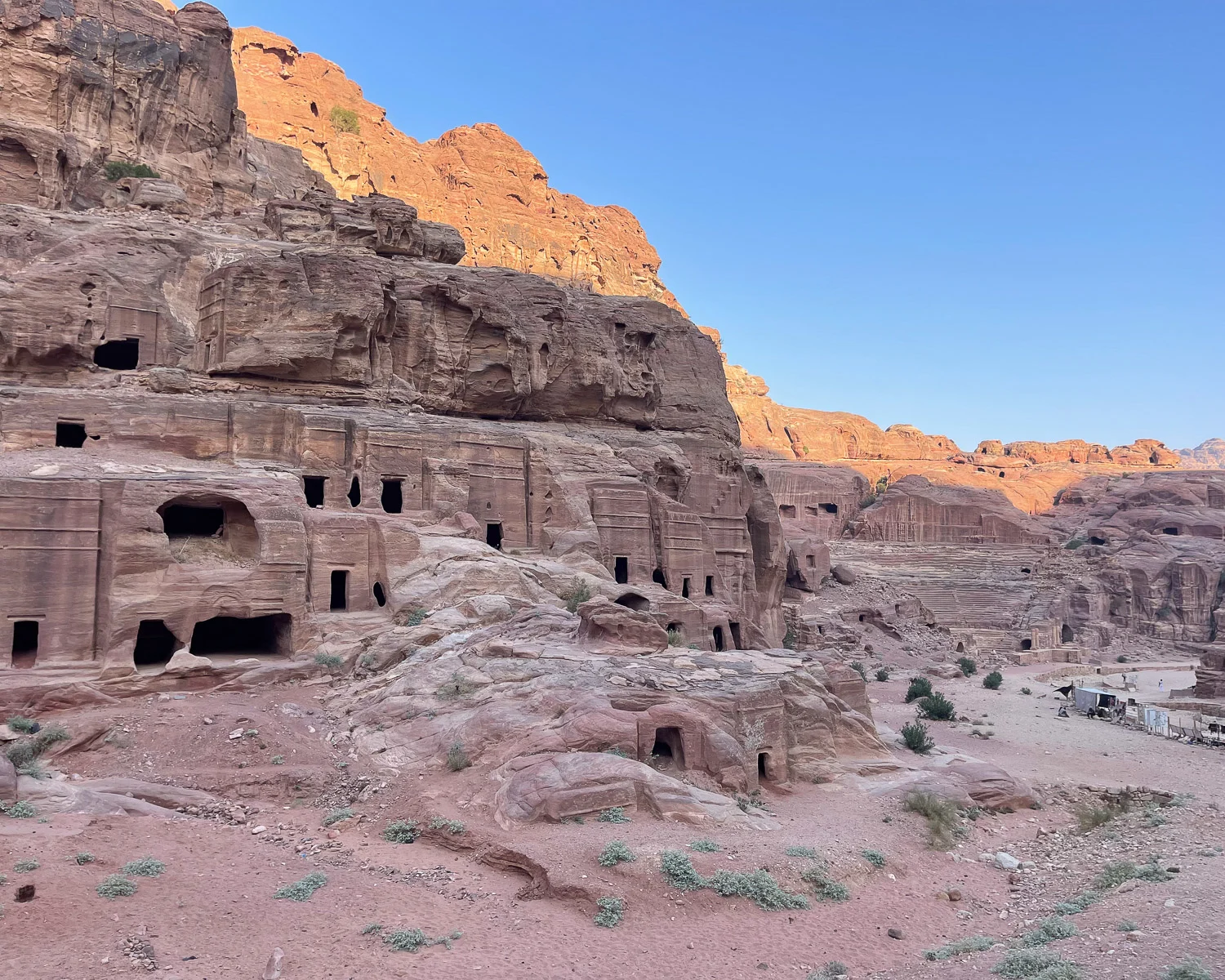
By Taxi
If you don’t want to drive yourself and prefer to have a taxi transfer, the JETT website has some easily bookable options for taxi transfers from Amman or Aqaba to Petra.
You can also ask your hotel to arrange a taxi transfer to take you to Petra. It’s also easy to arrange a taxi transfer to take you directly from Queen Alia International Airport (just south of Amman) to Petra, which is a 2.5 hour drive.
Take a group tour to Petra
If your whole holiday has been arranged as part of a tour, then transport will be taken care of. But if you arrive in Jordan as an independent traveller with no fixed plan, you can still take a group tour like the ones below.
3 day tour of Jordan from Amman – This tour includes an overnight stay and visit to Petra. The second night is spent in a desert camp at Wadi Rum, with a visit to the Dead Sea on the way back to Amman.
2 day tour of Jordan from Amman – This tour includes half a day visiting Petra, with an overnight stay and visit Wadi Rum and a quick stop at the Dead Sea.
Petra full day tour from Amman – For those with very limited time, this day trip from Amman is a good option, although bear in mind the drive is 2.5 -3 hours each way, so this will be a long day.
Petra full day tour from Aqaba – This day trip from the Red Sea resort of Aqaba allows for a 3 hour tour of Petra, so you’ll only get to see a few highlights.
Most tours start in Amman and take in Petra, Wadi Rum and the Dead Sea over the 2-3 day period. This could be a good option for solo travellers, but bear in mind you may only get half a day to see Petra.
That’s a shame, since Petra is a large and amazing site, that deserves at least 2 days to see the highlights. So if booking a group tour, check how long you will actually spend at Petra.
Read about our canyoning adventure at Wadi Mujib in Jordan

Need help to design your dream holiday? We’ve partnered with UK travel advisor Luxeco Holidays to create your personalised itinerary
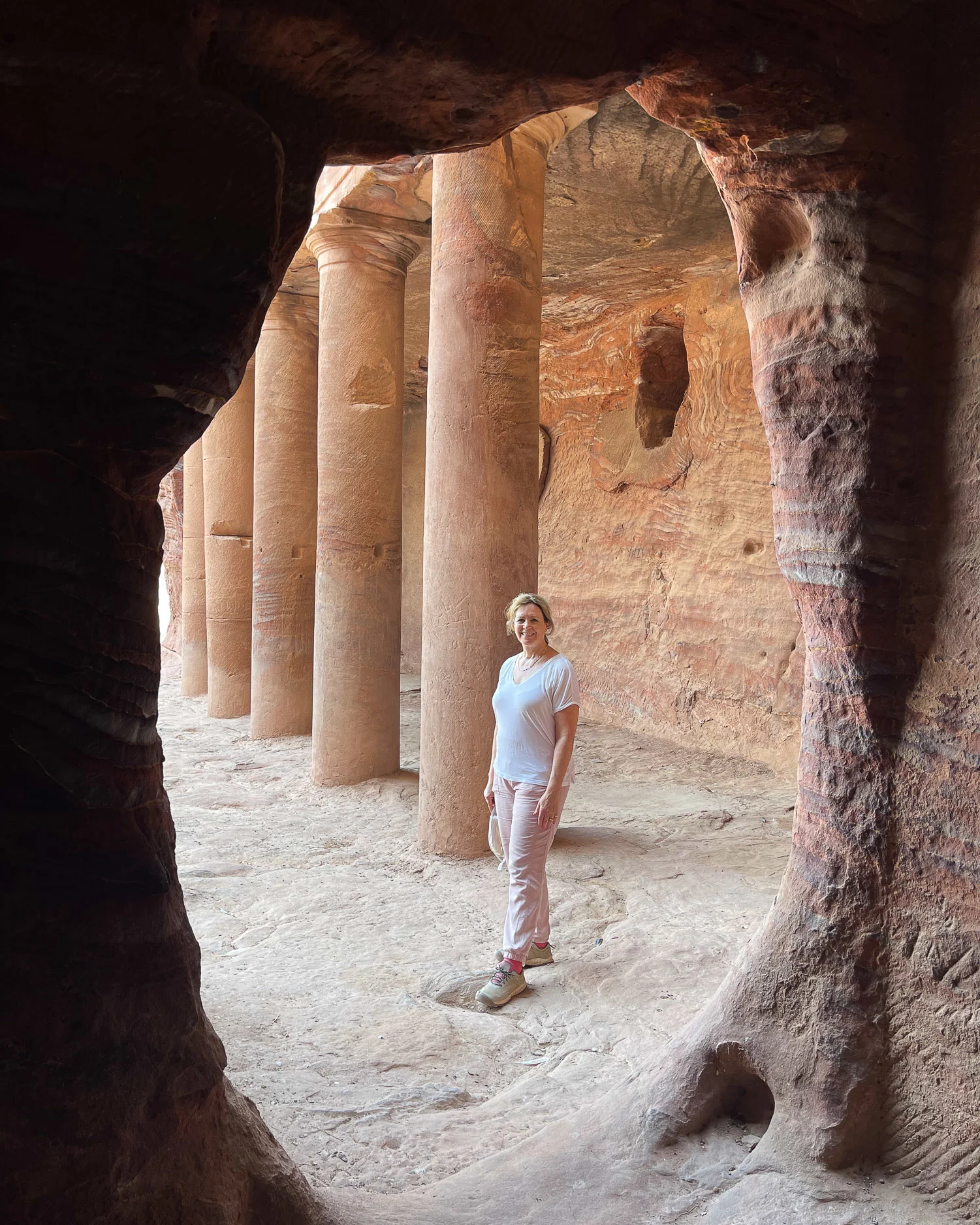
How long do I need to visit Petra?
We recommend spending 2 full days in Petra, if you want to see the main highlights at a comfortable pace. We had 2 days and 3 nights in Petra and felt it was about right.
If you have 3 days you can see the main highlights and additionally explore some of the interesting hiking trails that take you a little off the beaten track.
If you have only 1 day, you will need to start early and stay late to do justice to the site. Alternatively, you may need to leave some key sites such as the Monastery out of your itinerary.
Bear in mind that Petra is a huge archaeological site covering over 200 km square, with the main trail through it being around 8km in length. However long you stay, prepare yourself for a lot of walking!
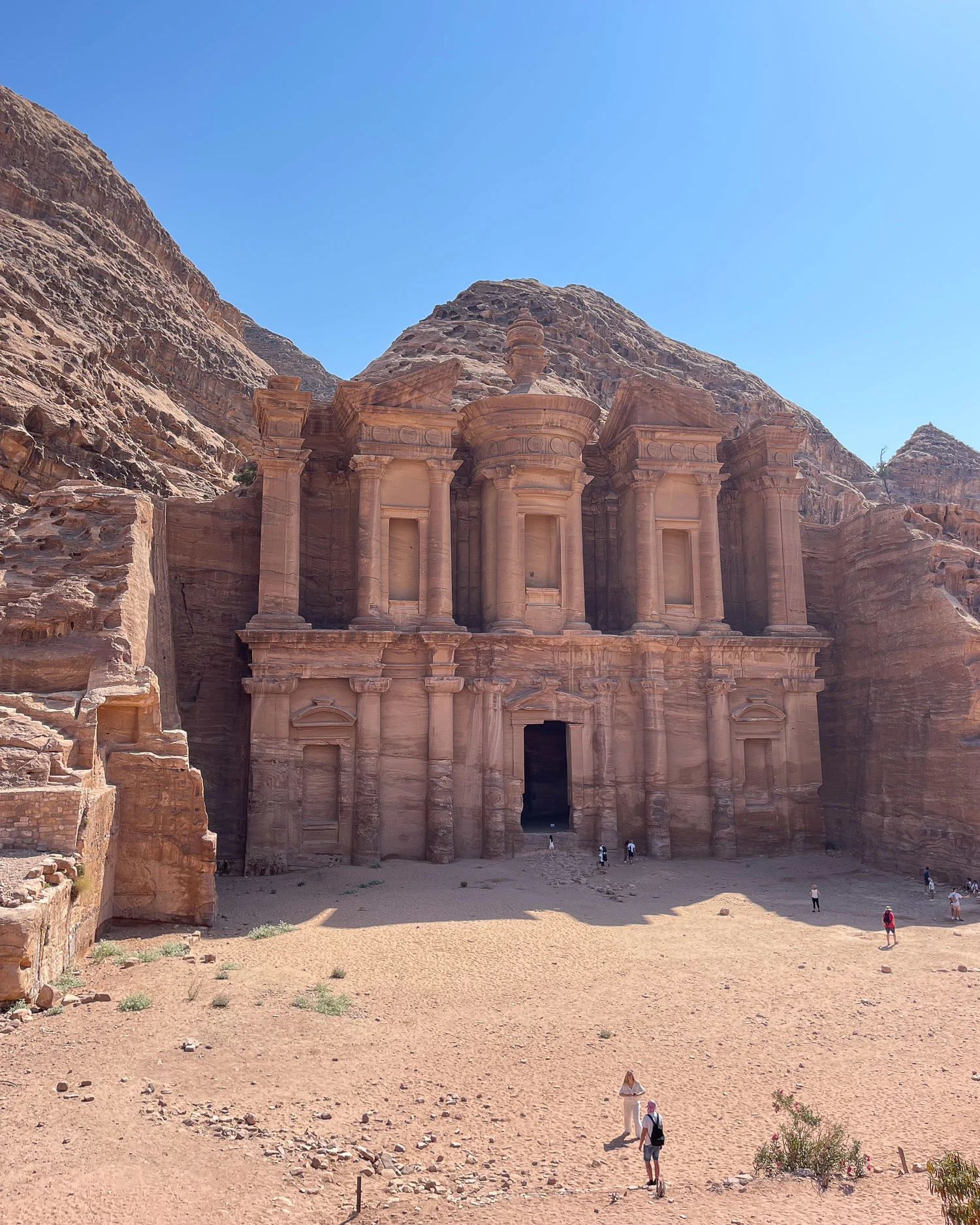
Best time to visit Petra
The best time to visit Petra is Spring (March – May) or Autumn (September to November) when the days are warm and sunny but not too hot for sightseeing. The evenings and early mornings can be cooler at this time, so be sure to pack a few extra layers.
In Spring the desert is at its greenest after winter rains, with wildflowers and oleander blooming. Rain mainly falls between November and March, but there can be occasional rain showers outside these months. Heavy rain brings the danger of flash floods in the narrow wadis or ravines around Petra, so watch the forecast and follow local advice.
We visited in August when the temperatures rose above 36 degrees celsius and can say from experience that it’s not the ideal time for sightseeing due to the heat! It wouldn’t have been our first choice but we were visiting Jordan for a friend’s wedding. We tried to beat the summer heat of Petra by getting up early and entering the site at 6.00am when it opened.
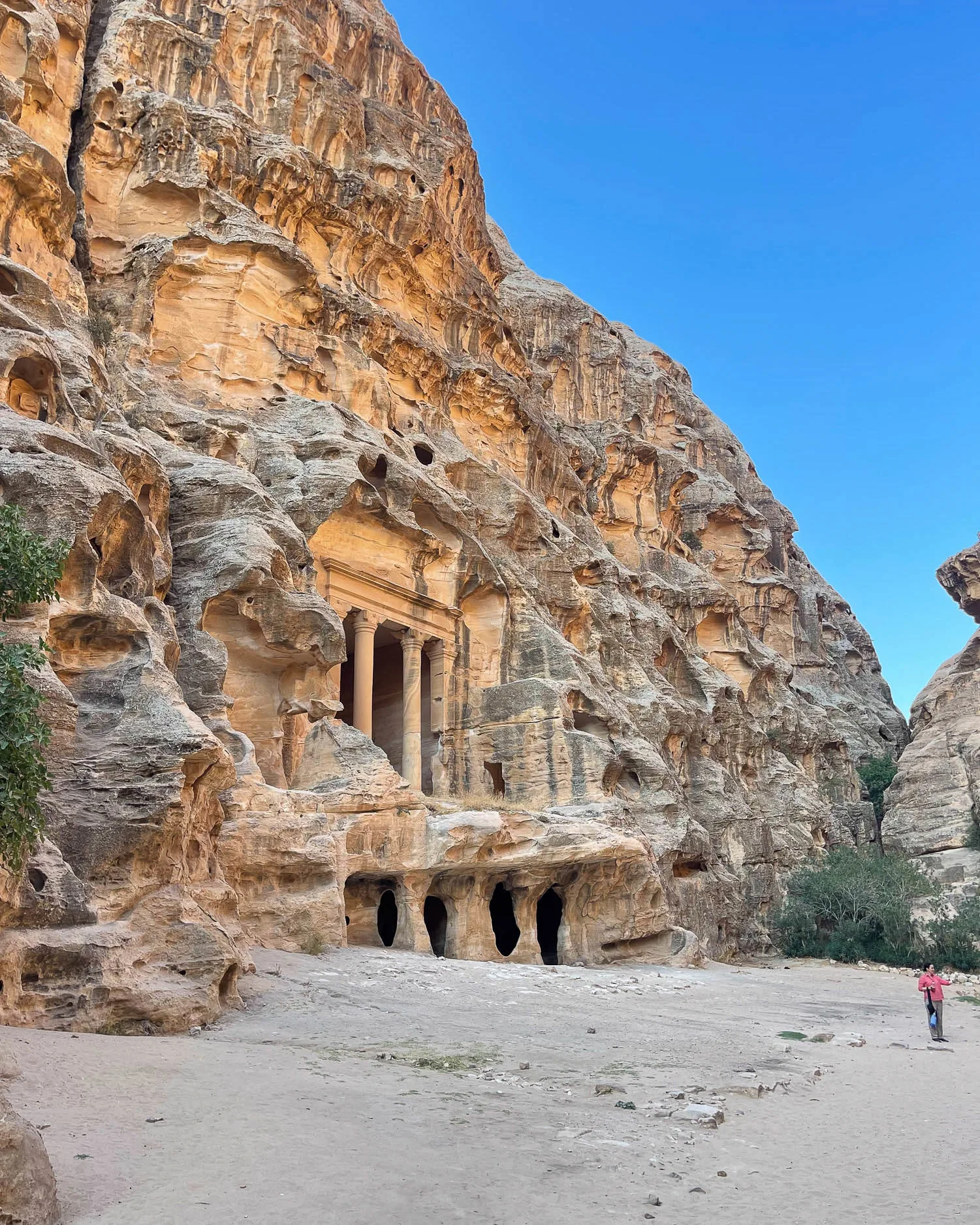
We also have another article about Petra, that covers the top things to do in Petra in much more detail including our recommended itineraries. Read: 20 best things to do in Petra – plus itinerary ideas
Petra travel guide – tips for when you arrive
In this section you’ll find our tips to organise your visit to Petra once you arrive, including buying tickets, opening hours and the Petra Visitor Centre.
Petra Visitor Centre
The Petra Visitor Centre is the point of entry to the Petra archaeological site, in the lower town of Wadi Musa. A short distance from the Petra Visitor Centre is the JETT bus station and several free car parks. Outside the visitor centre is an ATM machine.
On entering the Petra Visitor Centre (you may need to have your bag checked) there’s a courtyard with several souvenir shops and cafes. The centre itself has a ticket office, where you buy your ticket (if you don’t have a Jordan Pass). Both cash and cards are accepted, but there’s a small extra fee if you pay by card.
In the same hall as the ticket counters is a booth where you can engage one of the official guides at set rates that are posted on the wall (starting at 50JD for a 3 hour tour of the main Petra sights). You can also hire a guide for some of the more difficult hiking trails within Petra.
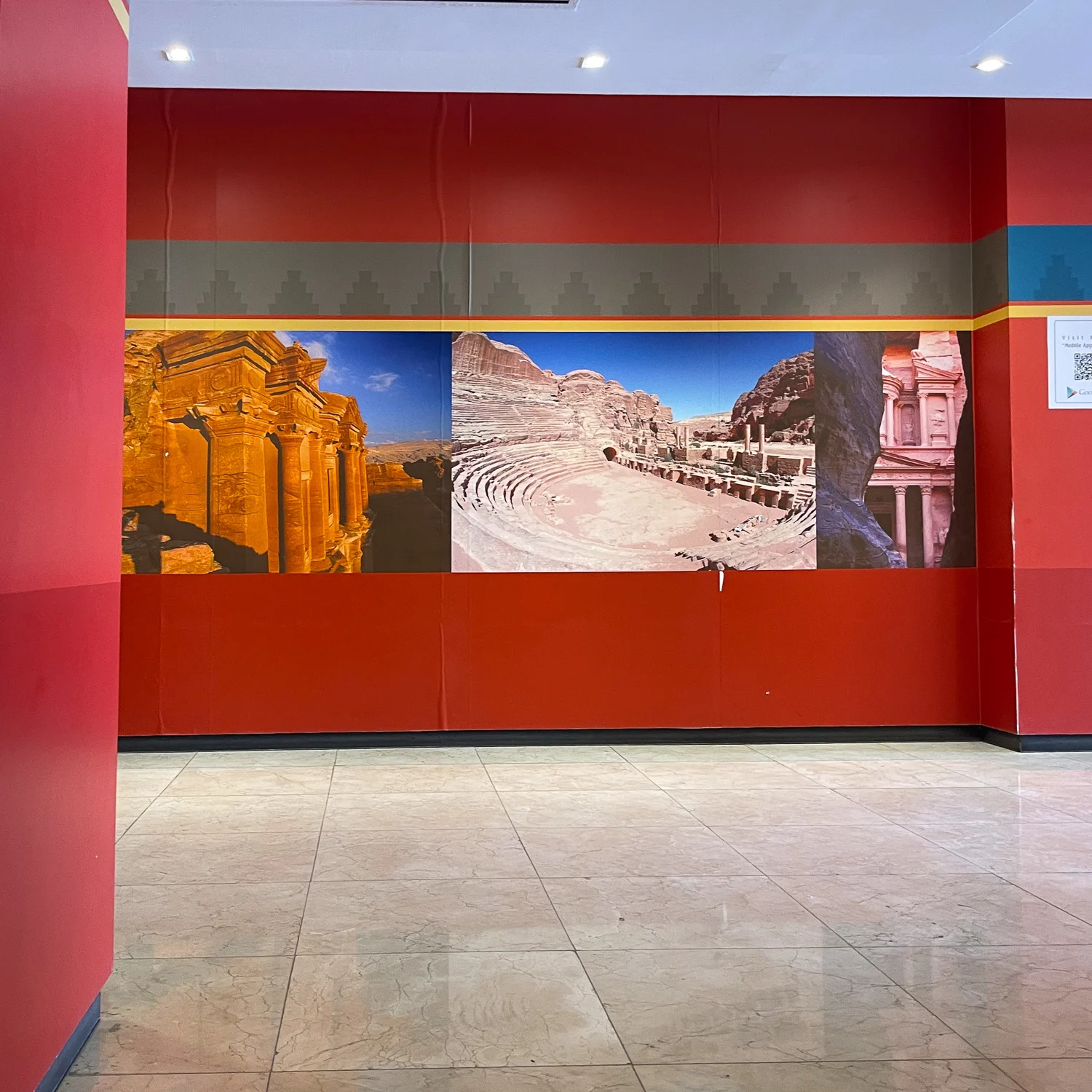
At the back of the visitor centre is an information counter and exhibition hall which gives background about the history of Petra. This is a useful place to stop on the way out, if you don’t have time to visit the Petra Museum, which is right by the Visitor Centre and also free.
Also within the Visitor Centre is a counter for sale of Petra by Night ticket, but these only go on sale a few hours before the event itself.
Tip: If you visit in hot weather as we did, both the visitor centre exhibition room and Petra Museum are blissfully air conditioned after a long hot walk back from the Siq.
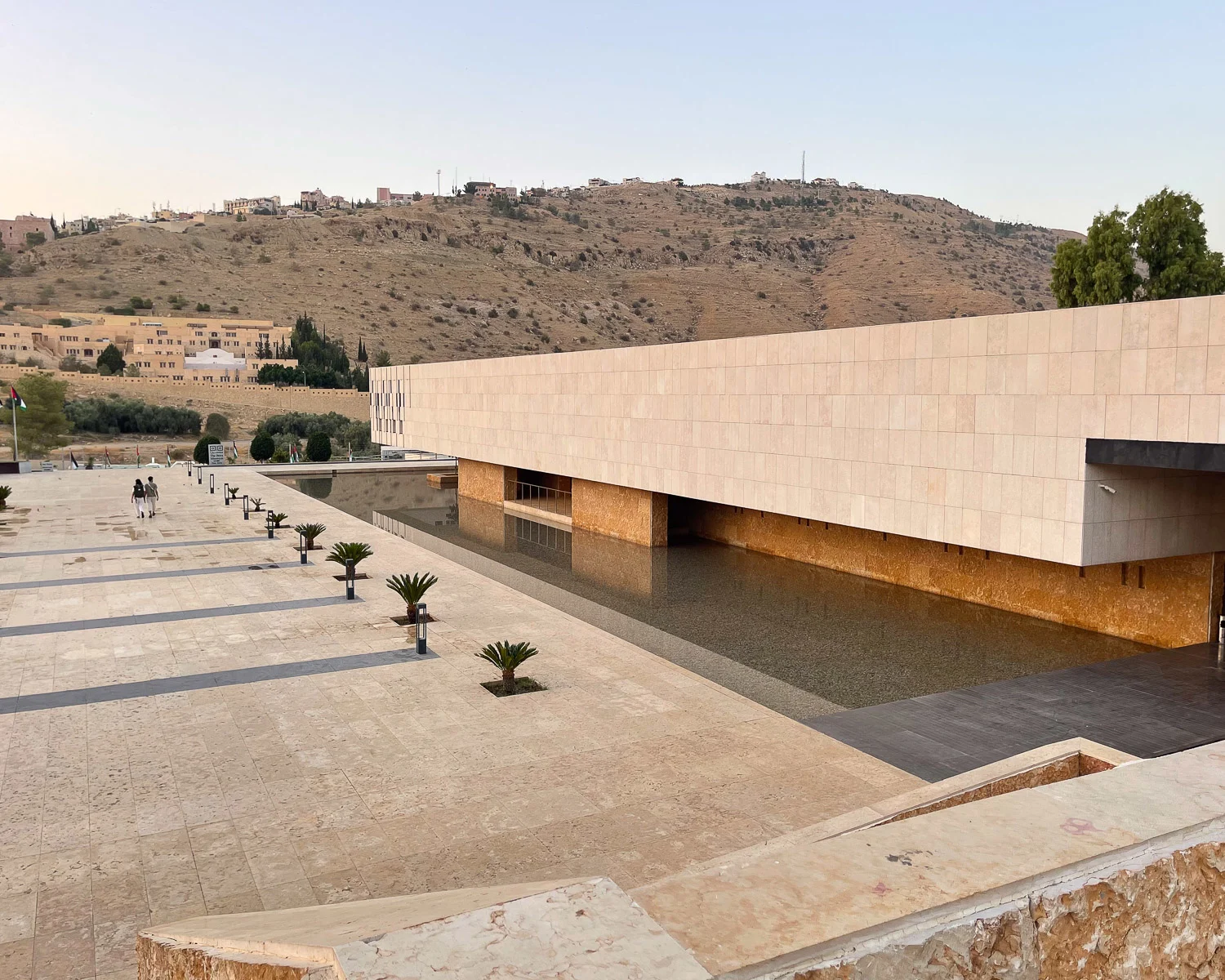
Opening Hours for Petra
The Visitor Centre and Petra archaeological site opens at 6am and closes at 4pm in winter and 6pm in summer. While your ticket will be scanned on the way into the site, on the way out there did not seem to be any check of who had left the site.
Having said that, there is no lighting within the site and staying overnight in Petra is forbidden, so you shouldn’t linger after the official closing time.
Ticket costs for Petra
The Jordan Pass
Before you plan your trip to Jordan and Peta, you need to know about the Jordan Pass. The Jordan Pass is available to purchase before you enter the country and includes the cost of your tourist entry visa and ticket to Petra, as well as free entry to some other attractions in Jordan.
You can buy the Jordan Pass online before you travel and the cost varies depending on how long you want to stay at Petra. A Jordan Pass for 1 day in Petra is 70JD, for 2 consecutive days at Petra is 75 JD and for 3 consecutive days at Petra is 80 JD. Since the Jordan Pass includes the cost of tourist entry visa, you need to buy before you arrive in Jordan.
If you buy your ticket for Petra at the visitor centre, the price is 50JD for 1 day, 55 JD for 2 days and 60 JD for 3 days. With the cost of the tourist entry visa being 40 JD, this means you save at least 20JD if you buy the Jordan Pass and possibly more if you use it to visit multiple attractions.
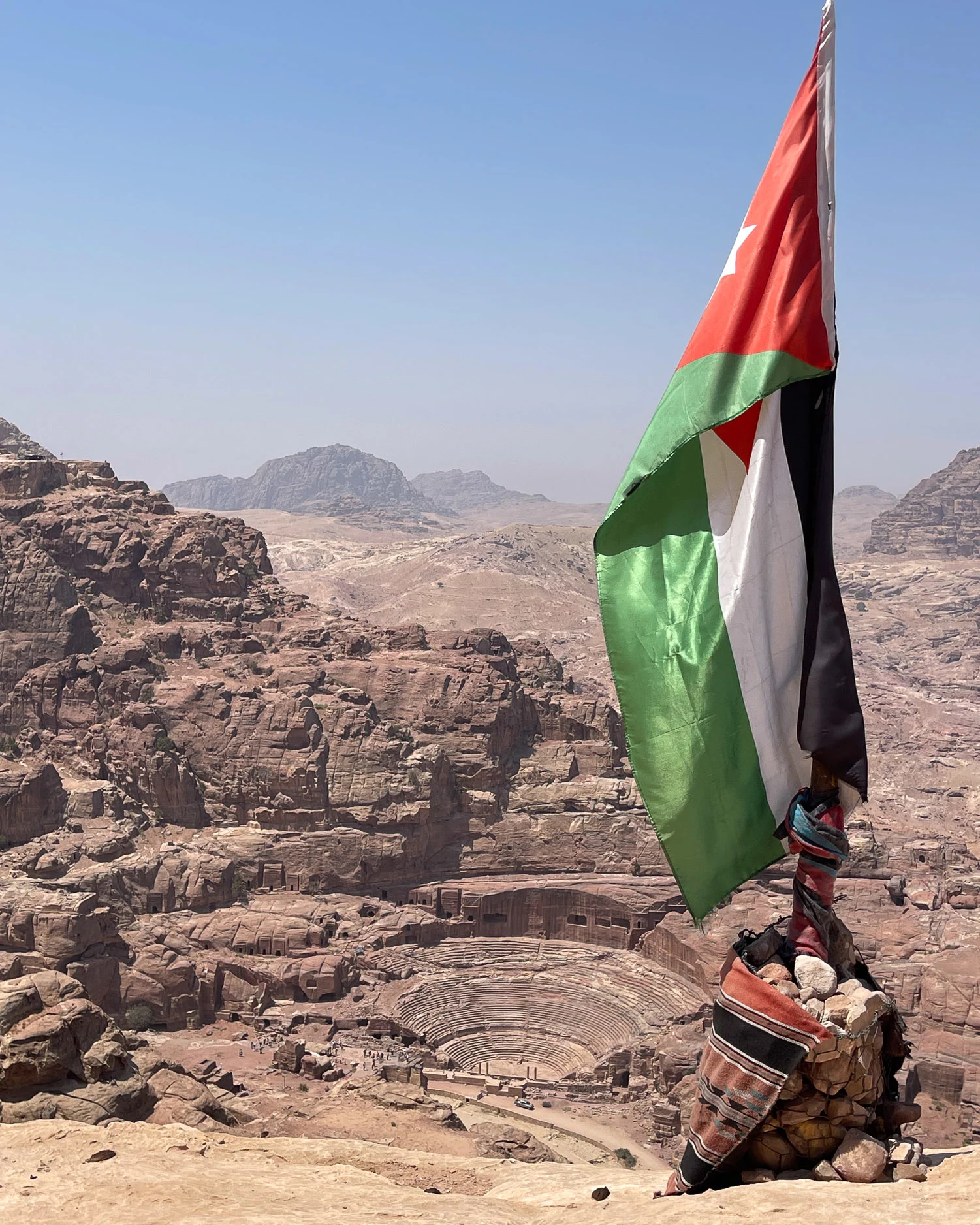
Buying tickets at the Petra Visitor Centre
If you find that the Jordan Pass does not work for you, you can just buy your ticket to Petra at the visitor centre. If in doubt about how many days you will be visiting Petra, I’d book the ticket allowing 2-3 days, since each extra day only costs 5 JD more.
The prices mentioned above are for visitors who stay at least 1 night in Jordan. Non-accommodated visitors or local residents pay a different rate. Children under 12 go free. You need a Petra general ticket (either via the Jordan Pass or the ticket office) to attend Petra by night but there is an additional charge to buy the Petra by night ticket.
If you are visiting Petra as part of a pre-booked tour, check whether the entry ticket to Petra is included in your tour fee.
Important: You need to show your passport at the visitor centre when you buy the tickets, or when you show your Jordan Pass to pick up the ticket.
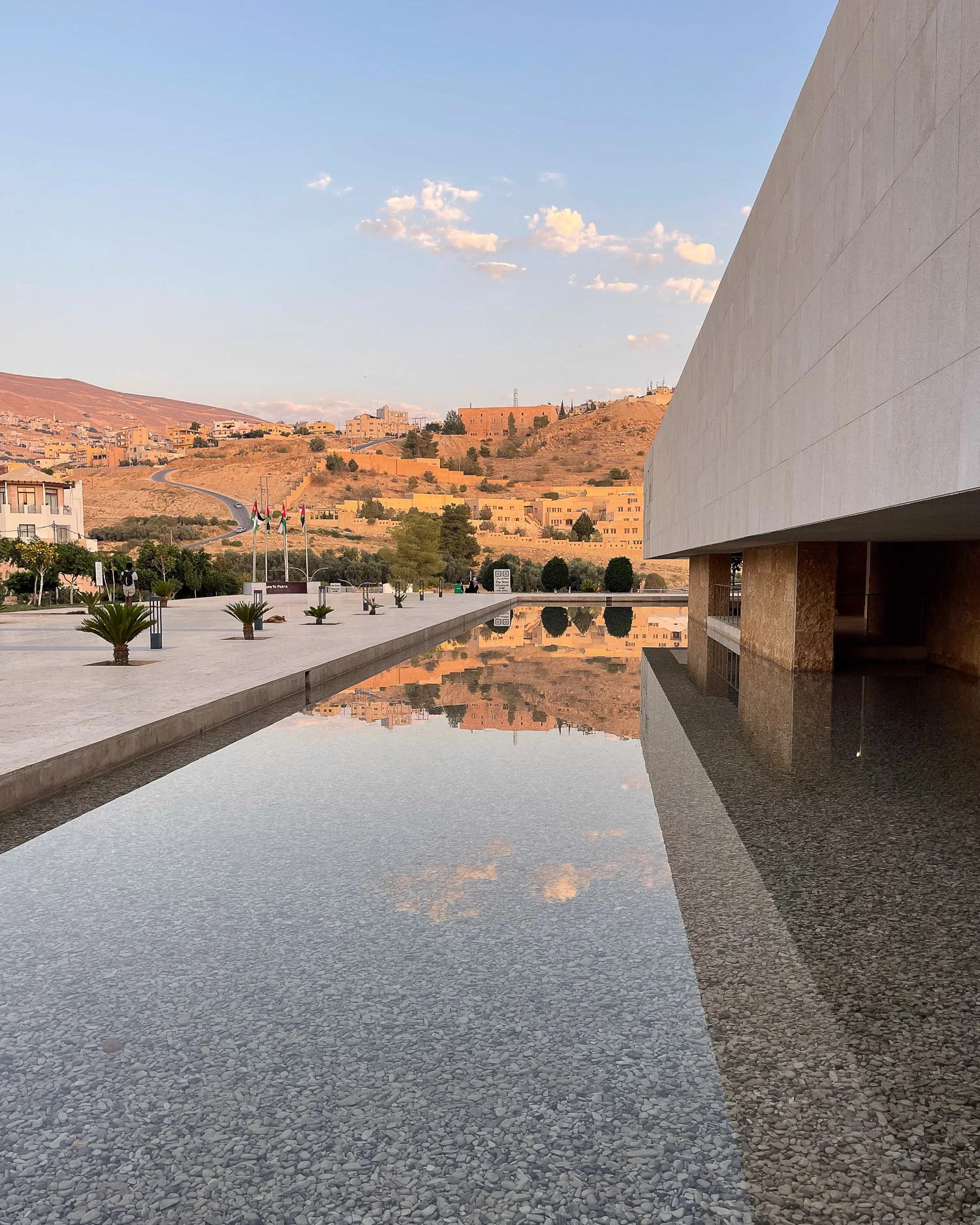
Petra Jordan – tips for visiting the site
In this section of our Petra Jordan guide, you’ll find our tips once you are inside the Petra archaeological site, including what to see, how to plan your time in Petra and maps to navigate the site.
A brief history of Petra
It’s amazing that the history of the Nabataean people, who built Petra, is so little known, considering they once dominated the region.
Originally pastoral nomads, the Nabataeans grew rich by controlling the lucrative overland spice trade from Asia to the Mediterranean. Their capital, Petra was built from the 1st century BC, as a hidden city on the trade route, where merchants could rest safely before moving on across the desert.
As the spice trade shifted westwards to easier routes along the Red Sea and Dead Sea, the Nabataean Empire declined, and the Romans eventually annexed their territory. Petra continued as a thriving Roman settlement, until an earthquake in the 4th century AD destroyed much of the city.
In later centuries Petra was abandoned and taken over by local Bedouin who used some of the tombs and buildings as houses. But a visit in 1812 by a Swiss Explorer who entered the city disguised as an Arab pilgrim, awakened the interest of 19th century European travellers in Petra.
Artists such as David Roberts who visited Petra in 1839, created paintings and lithographs that are still sold in Petra today and put the ‘Rose-Red City’ on the wish list for many Victorian travellers.
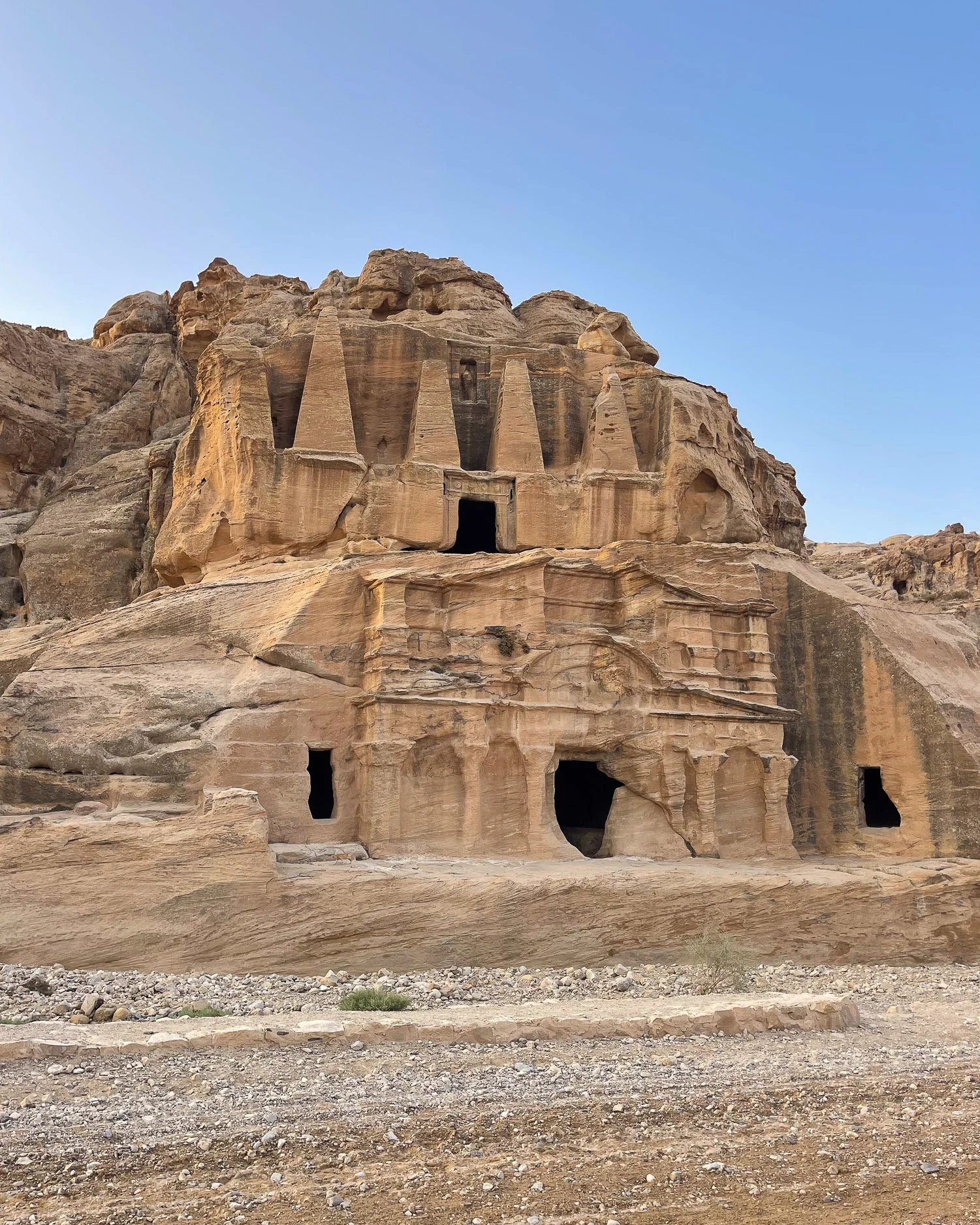
Top things to see in Petra
For more information about these highlights, read my article about 20 best things to do in Petra – plus itinerary ideas
Petra in one day
If you just have one day, I’d walk down the Siq to the Treasury, then take the trail up to the High Place of Sacrifice. After coming down by the same route, bypass other attractions as you walk to the Basin area and have a rest and snack at one of the 2 restaurants.
Then climb up to the Monastery and after seeing it, come back by the same route. For the rest of the afternoon, explore the Royal Tombs, allowing a further hour to walk back from there to the Visitor Centre. Phew! that was a long and tiring day!
- The Siq – This narrow gorge leads the traveller into Petra, ending with the much photographed view of The Treasury. The gorge was created as a natural split in the rock, with layers of different coloured sandstone.
- The Treasury (Al Khazna) – The best known view of Petra, this is the monument that you meet first, carved into the face of the cliff. The small rooms behind the facade were made as the tomb of a king in the 1st century, and the name derives from the legend that treasure was once concealed in some part of the building.
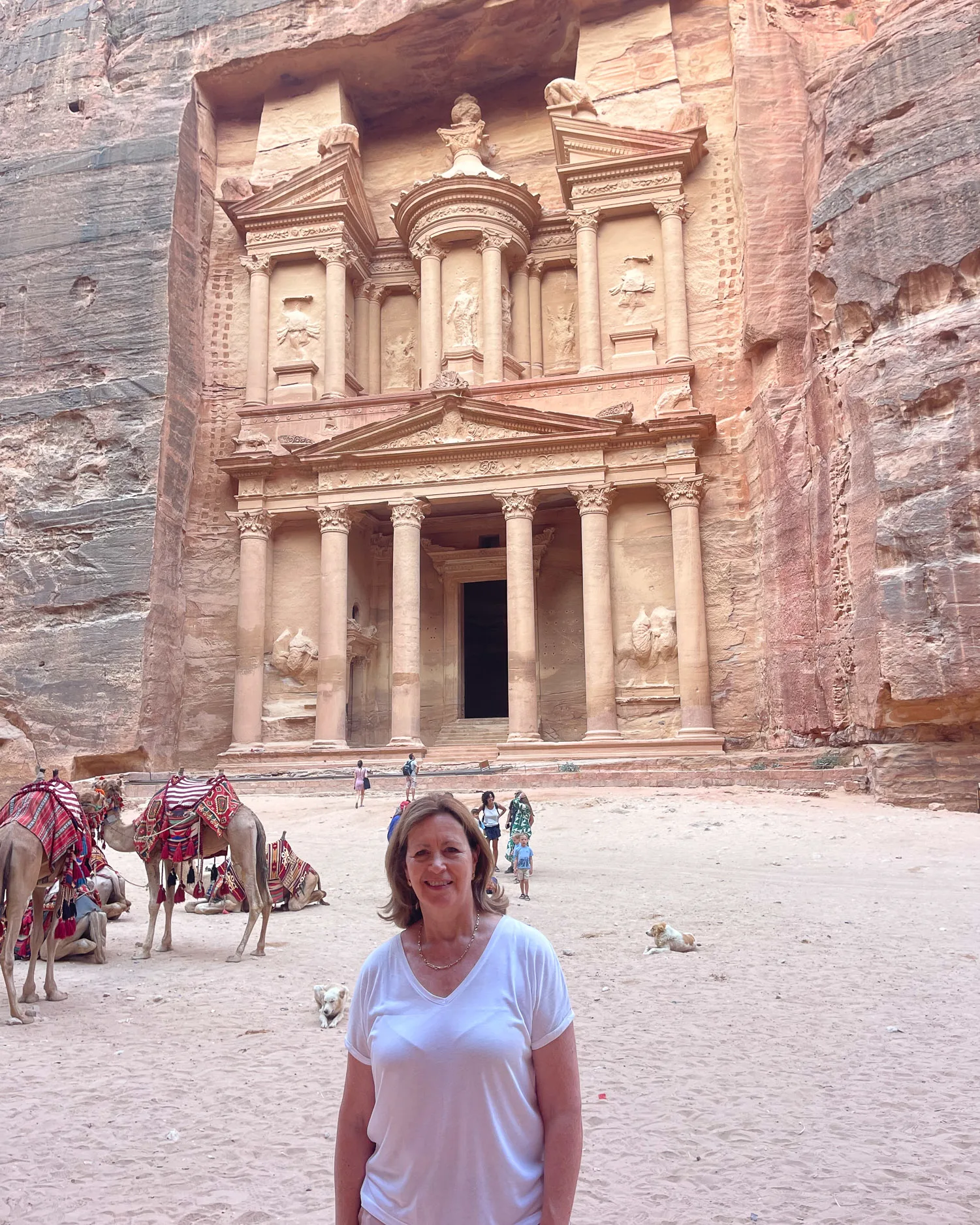
- High Place of Sacrifice – After the Treasury, a path leads up through a gorge bringing you to a plateau with amazing views of the ancient city below. At the highest point is a rock altar that was used for religious ceremonies and sacrifice.
- Royal Tombs – Carved into the cliff face are four major tombs, with large chambers that you can enter, although they are now empty. You’ll admire the intricate rock carving from the 1st and 2nd century AD and the swirling coloured layers of stone.
- The Monastery (Ad Deir) – At the furthest end of the site from the Treasury, 800 steps lead up a gorge on an arduous hike to the Monastery. This carved facade of a tomb rivals the Treasury in its size and magnificence, and is so called because it was later used as a church.
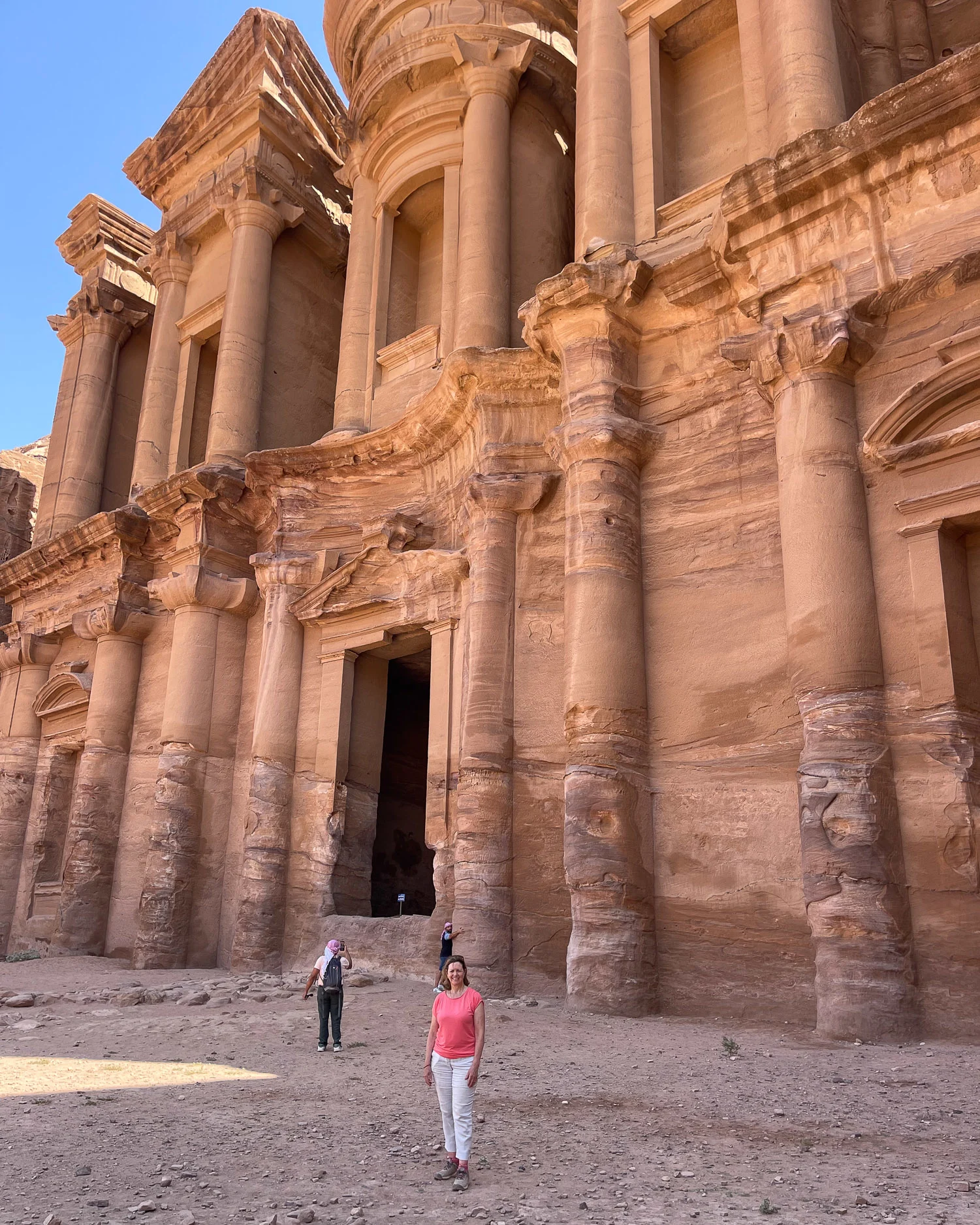
More Petra highlights if you have time
If you have additional time after covering the key highlights above, here’s what you should see.
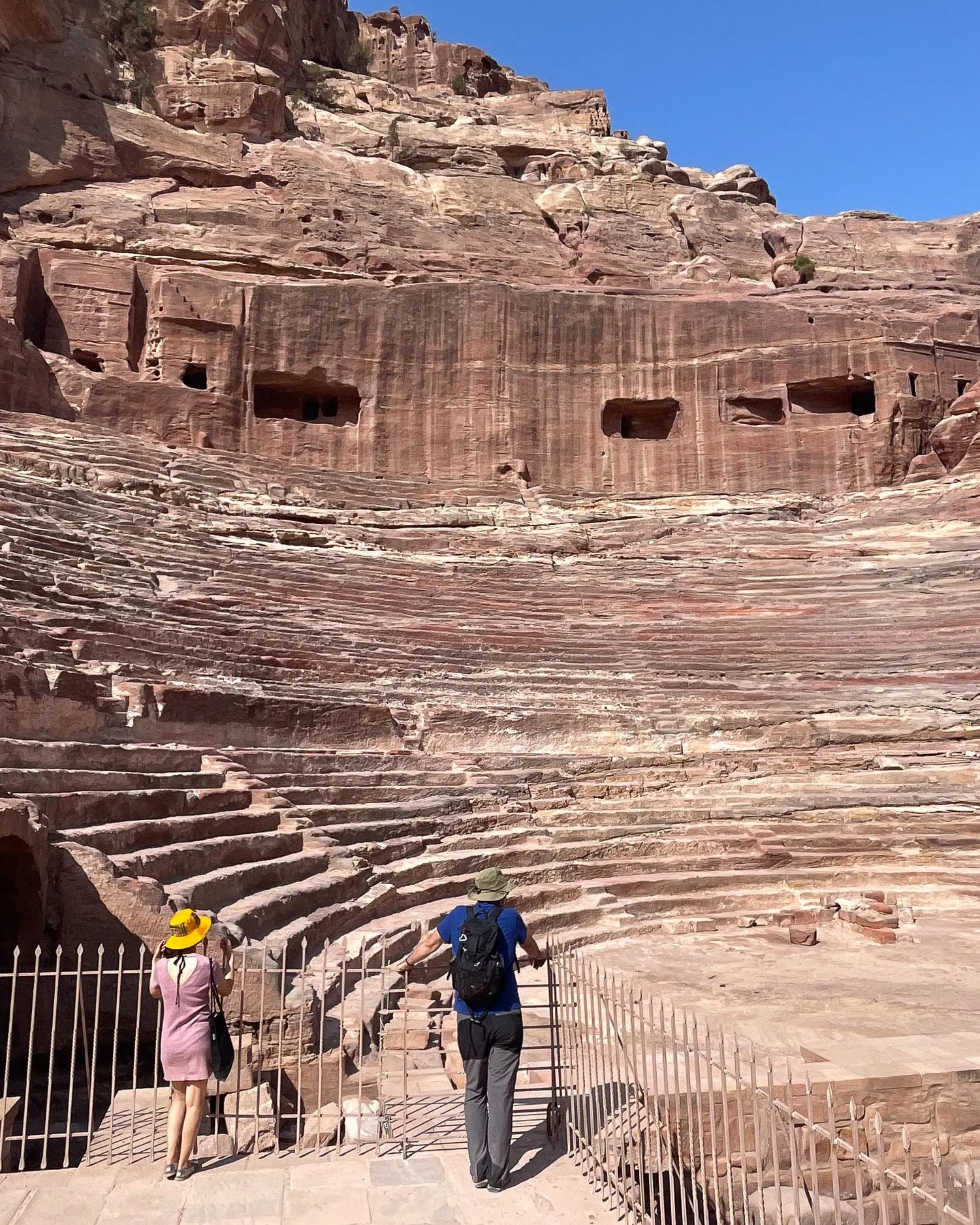
- The Theatre – a theatre built by the Nabataeans and repurposed by the Romans, that could hold up to 4000 spectators.
- The Great Temple – the remains of the ancient temple complex with columns and remains of the stone walls, built in the 1st century BC by the Nabataeans.
- The Colonnaded Street – the remains of a colonnade that was built by the Nabataeans as the city’s main shopping street.
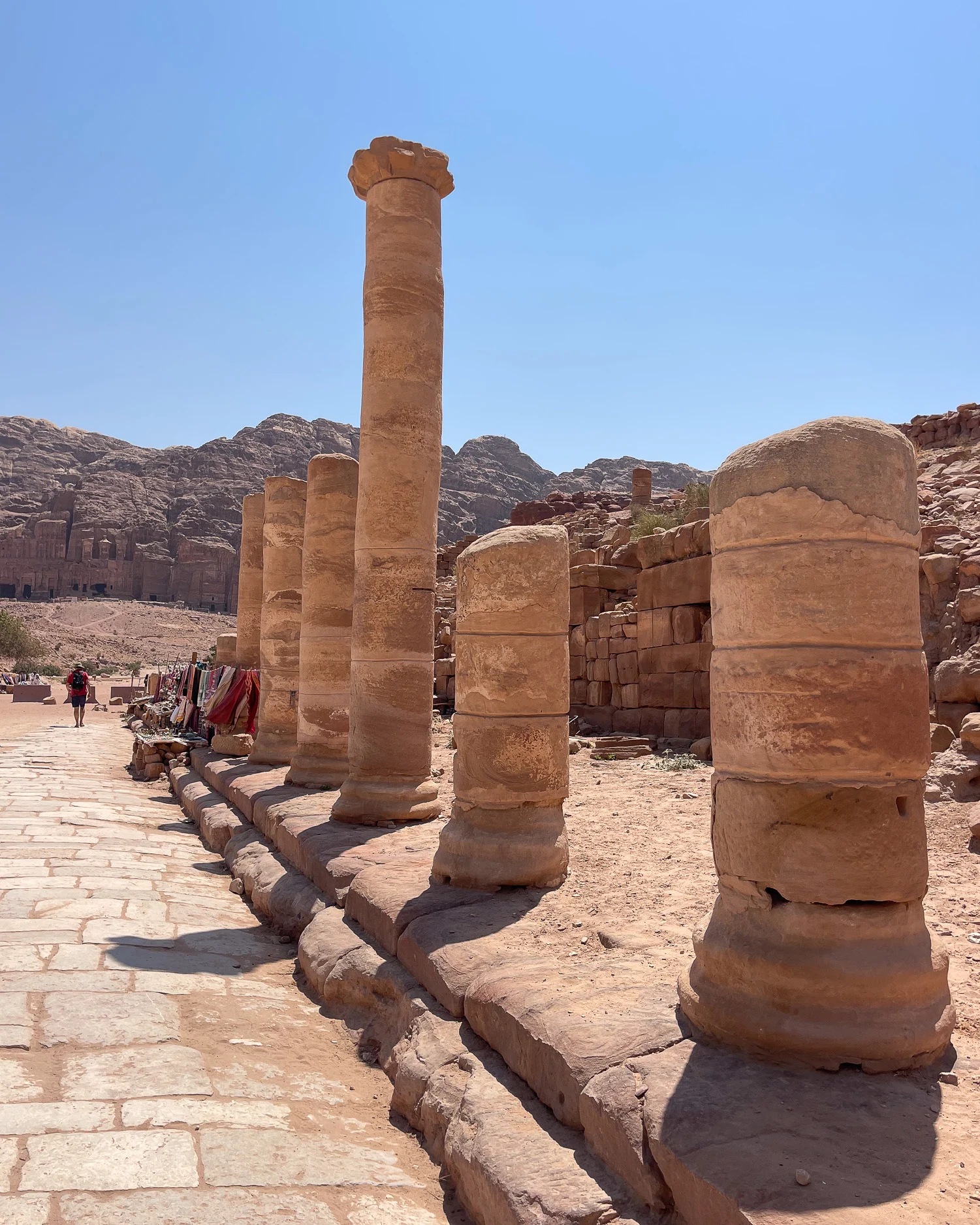
- The Church – built around the 5th century, with a well preserved mosaic floor.
- The Treasury Viewpoint – behind the Royals Tombs is the start of a trail (Al Khubtha Trail) which takes you on stone steps up to a viewpoint looking down on the Theatre. After a further scramble downhill to a Bedouin tent on the cliff edge, you get a view over the Treasury. Be warned it’s an arduous trail that takes 2-3 hours round trip. There’s another more accessible viewpoint which you climb from the Treasury area, but you may need to tip a local ‘guide’ to take you up there.
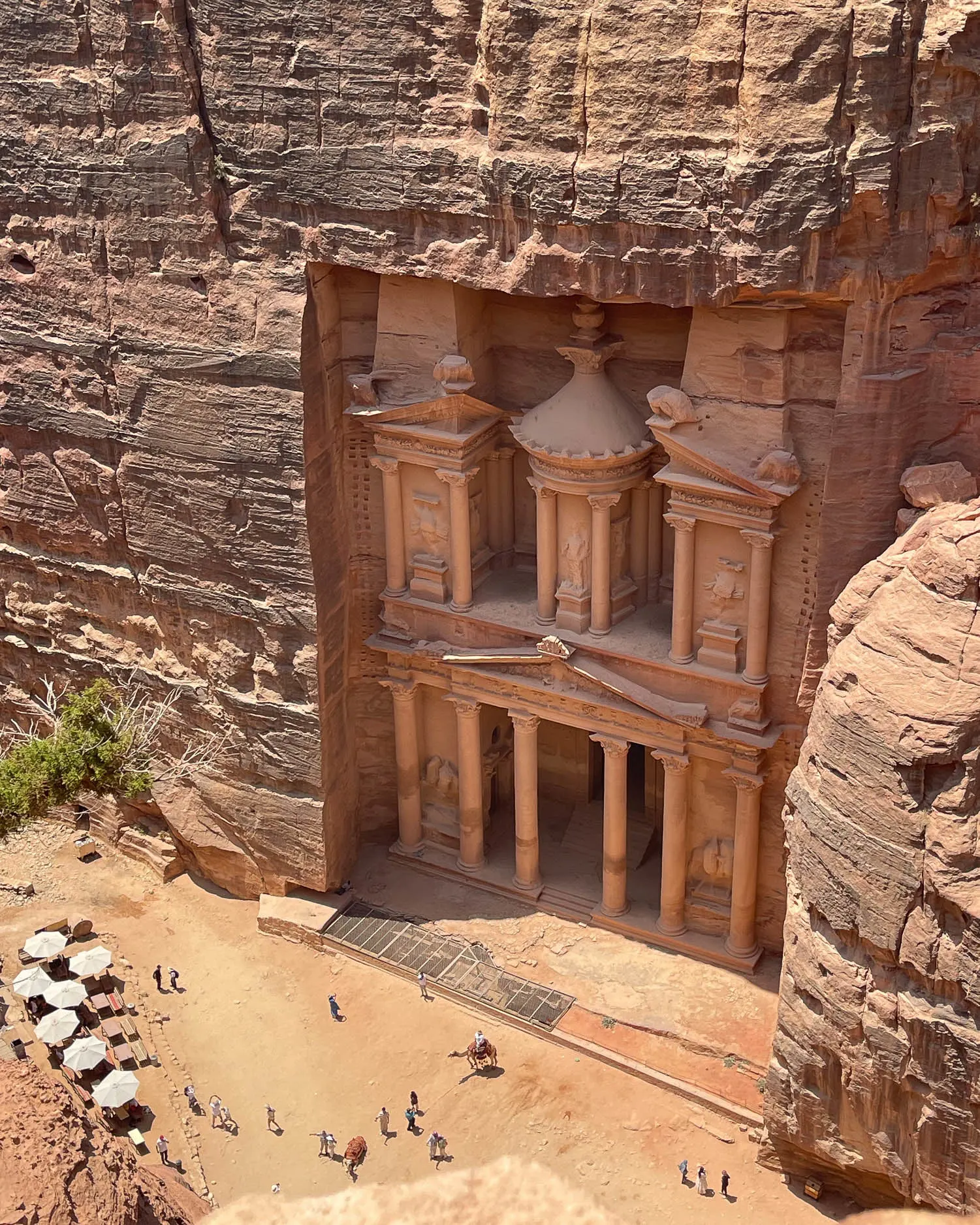
- The Petra Museum – this excellent modern museum is right by the visitor centre and is free to visit. It tells the story of the Nabataeans and history of Petra, with all the main artefacts that were found at the site. The Museum stays open quite late, allowing you to visit after your day at Petra.

Need help to design your dream holiday? We’ve partnered with UK travel advisor Luxeco Holidays to create your personalised itinerary
Highlights outside the main Petra site
These are well worth visiting and could be fitted in on your second day, bringing you into Petra by the ‘Back Door’ and down to the Petra Old City area by lunchtime. After refreshments at one of the Basin restaurants, you can visit further sites such as the Temple and Colonnaded street, before returning via the Treasury and Siq.
- Little Petra (Siq Al-Barid) – This smaller gorge area with carved tombs and facades is a short drive from the main Petra site and is much quieter and smaller. It’s well worth a visit and there’s a free car park, or a free minibus shuttle that will take you there from the back of the Petra Visitor Centre (first shuttle 7.30am).
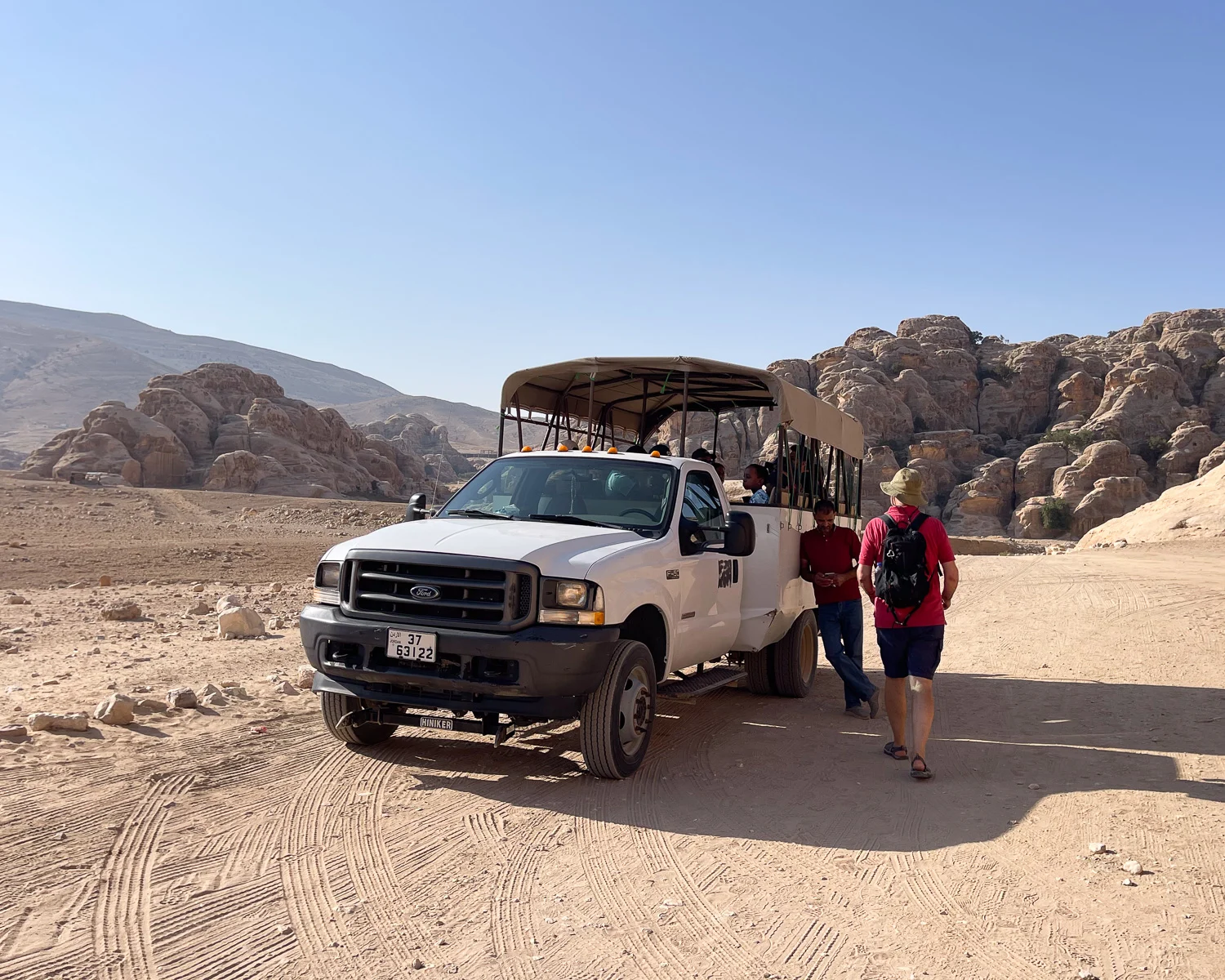
- The hike from Little Petra up to the Monastery – From Little Petra a 20 seat 4 wheel drive vehicle is available to drive you (cost 5 JD cash) to the start of the hike up to the Monastery. From where you are dropped off the trail is obvious and easy to follow, bringing you up to the Monastery by the so called ‘Back Door’ of Petra. The trail winds along the side of the cliff, with stunning views. Being a lot less crowded than the main Petra site, this was one of our personal highlights. You need to have already purchased your Petra ticket to take this trail, since tickets are not sold at Little Petra.
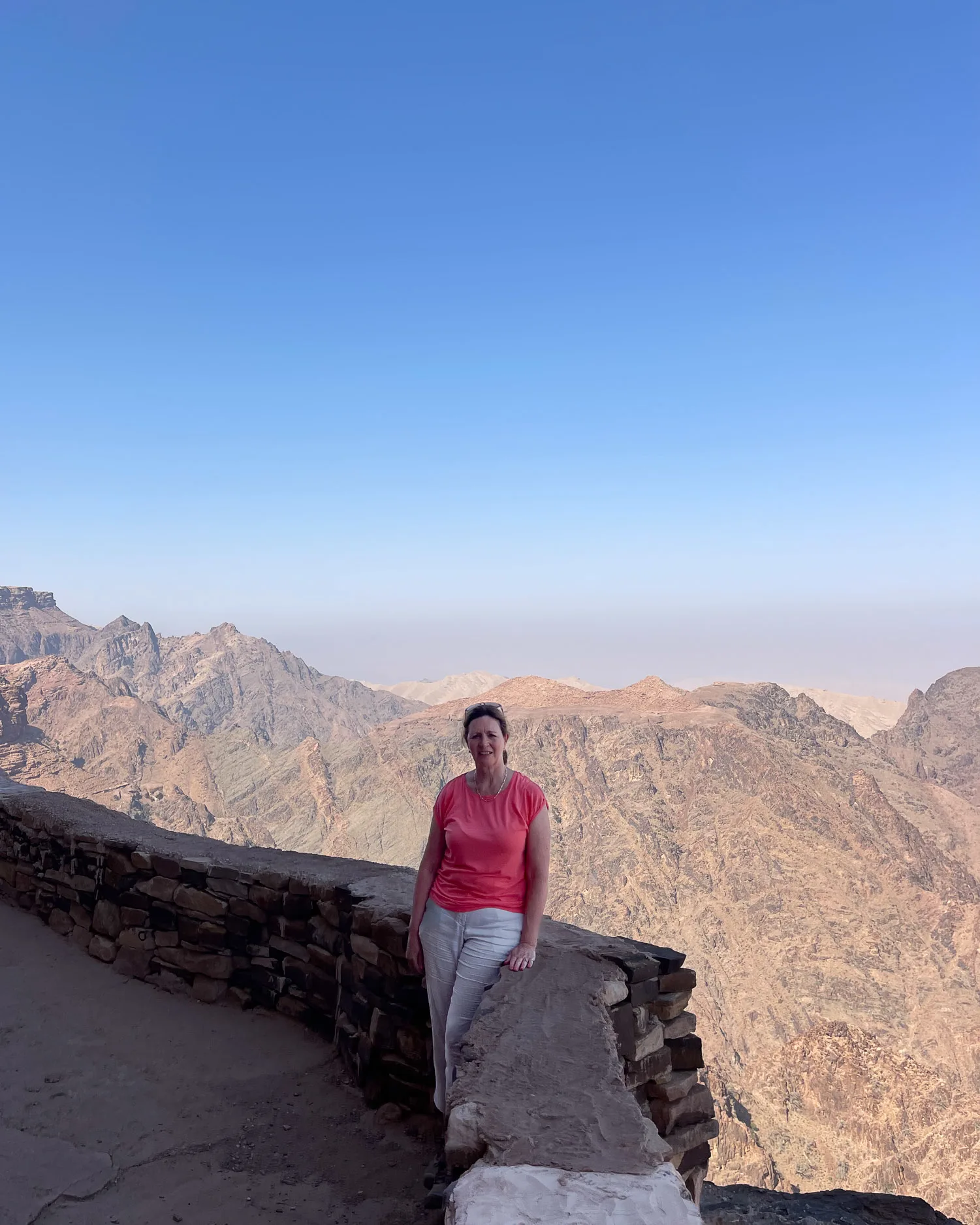
Petra by Night tickets
Petra by Night is a chance to experience the area in front of the Treasury after dark, lit up by hundreds of flickering candles. You need to have a general ticket for Petra to attend, and you need to buy an additional Petra by night ticket. The cost of the Petra by night ticket is 17 JD with children under 10 going free.
Petra by night happens every Monday, Wednesday and Thursday, so it’s worth timing your visit for one of these days. The experience starts at the visitor centre at 8.30 pm when you are allowed to walk down the track, into the Siq and on towards the Treasury. The event is finished by 10.30pm, when you leave the Treasury area to walk back to the visitor centre.
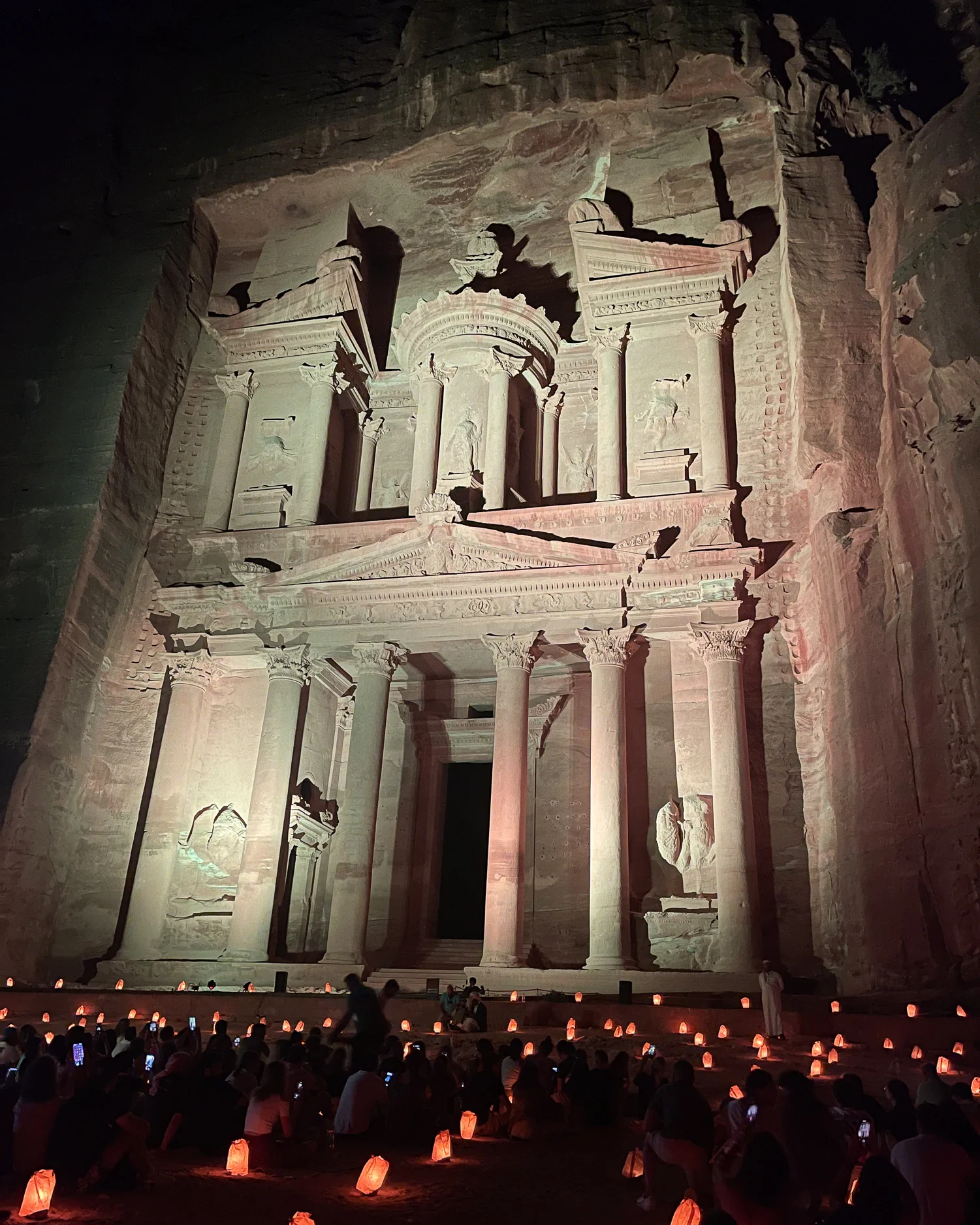
Our Petra by Night experience
We had a fun experience and were glad that we had done Petra by night. Arriving at the Visitor Centre 20 minutes before the start time, we found that a long queue was already developing.
Once the gates were opened we walked down the path which was lit on both sides by flickering candles. Some of the rock carvings en route were also illuminated. Passing through the Siq we reached the Treasury where hundreds of lamps were burning on the sandy ground in front of the Treasury.
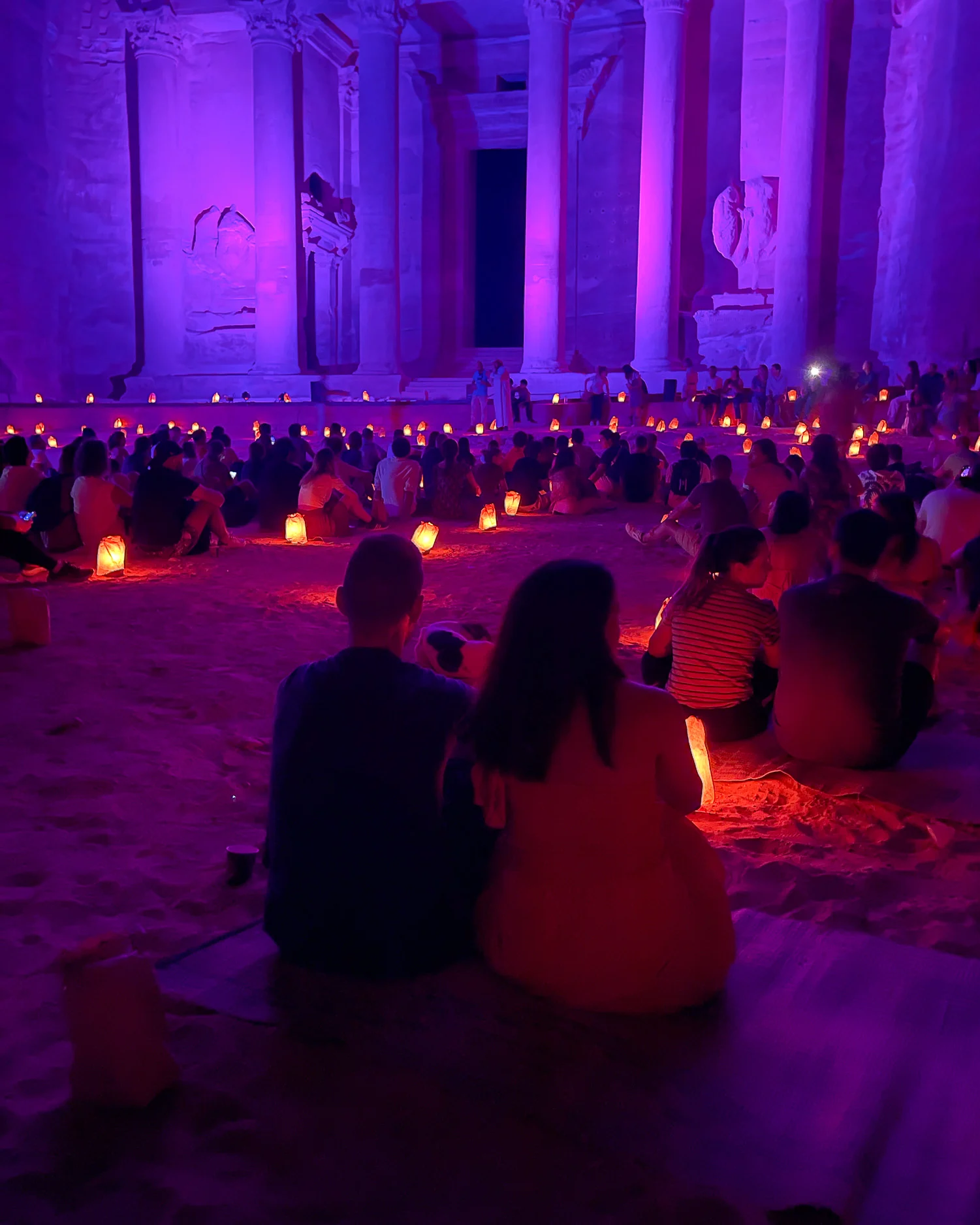
We took a seat on the rows of stools, which were arranged towards the back with empty space in front. The space in front of us was gradually taken up by those who arrived later and had to sit on mats the ground.
The performance involved an introduction to the history of Petra, followed by a performance of some traditional music. We were also served a complimentary cup of mint tea. Throughout, the Treasury was lit up with a succession of different colours.
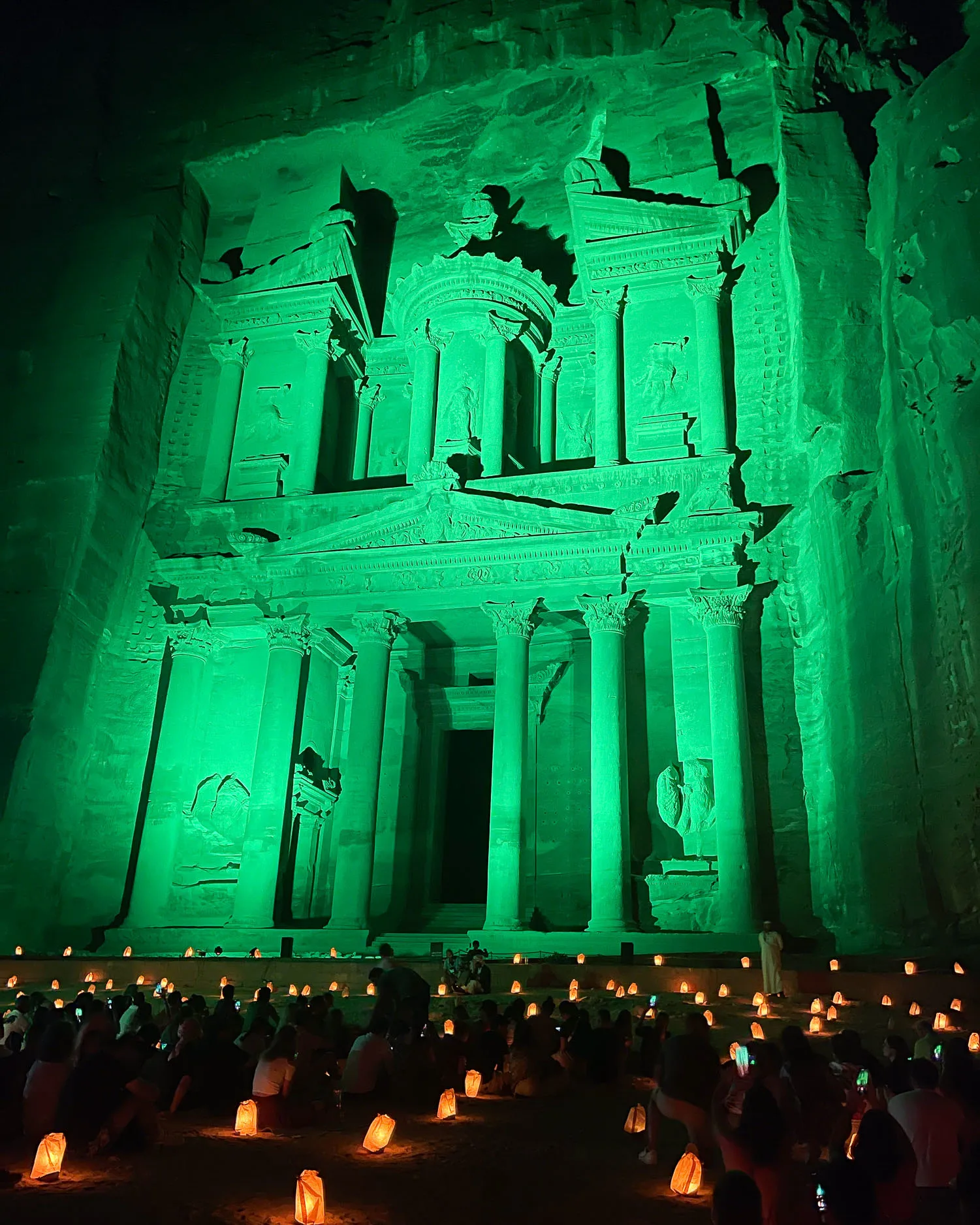
The narrator made a point of telling us that this would not be some slick light show but an authentic cultural experience. While this was the case, it all felt quite low key, considering that it happens so regularly for so many people.
You might imagine a quiet and magical experience, allowing you to appreciate the beauty of Petra by candlelight. The reality was hundreds of people in a confined area, all chatting and taking photos. Throughout the performance, latecomers were constantly being ushered through to find a seat in front of us, which was quite distracting.
My advice is to arrive as early as possible to take your photos and get a seat in the front row of the stools (unless you want to sit on the ground). Then relax and take the whole experience as it comes, without too many pre-conceptions.
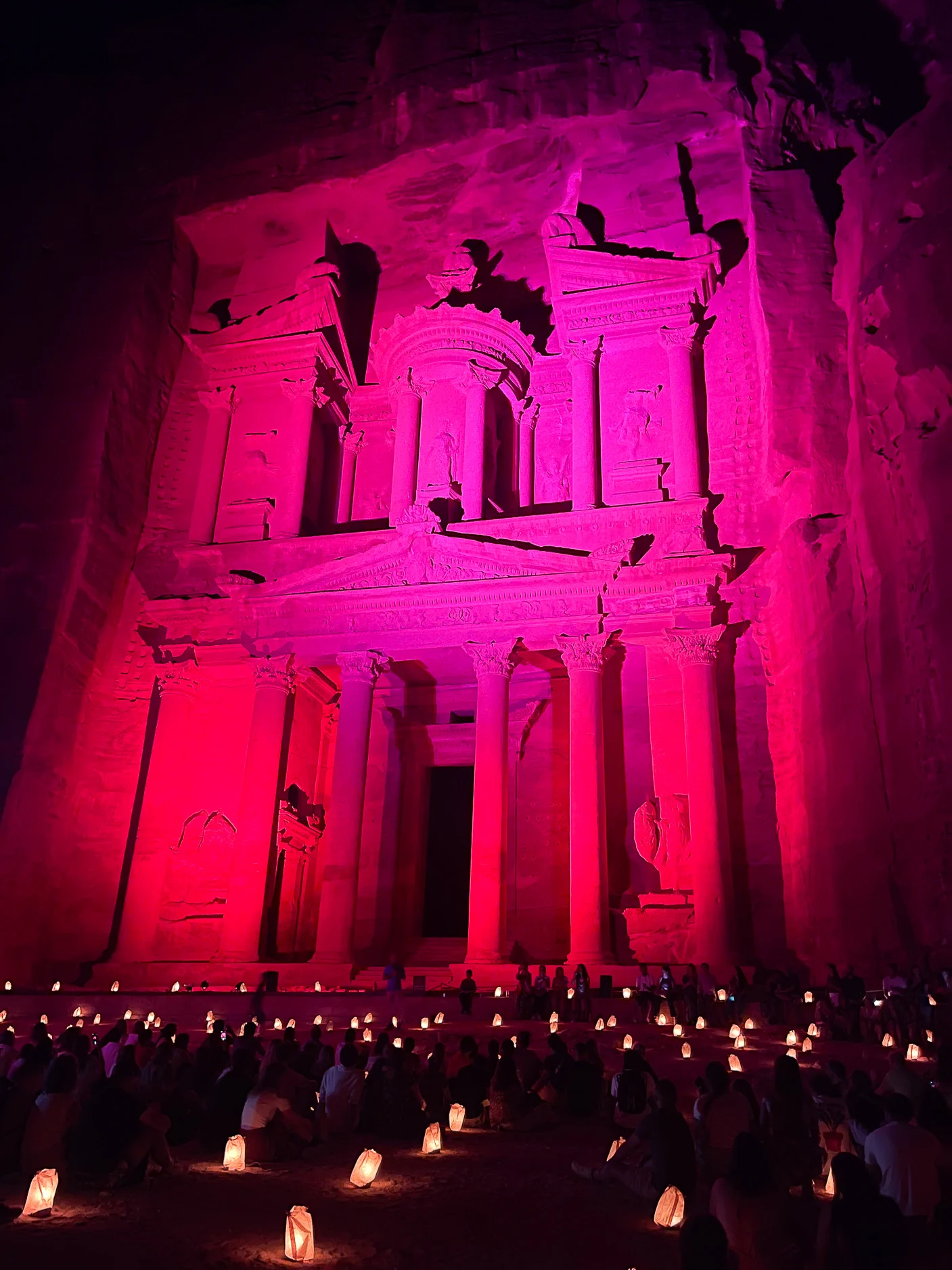
We also have another article about Petra, that covers the top things to do in Petra in much more detail including our recommended itineraries. Read: 20 best things to do in Petra – plus itinerary ideas
Map of Petra Archeological site
Paper maps are available in several languages including English from the Petra Visitor Centre. We could not find any copy of this map online, so we’ve taken a photo of it below.
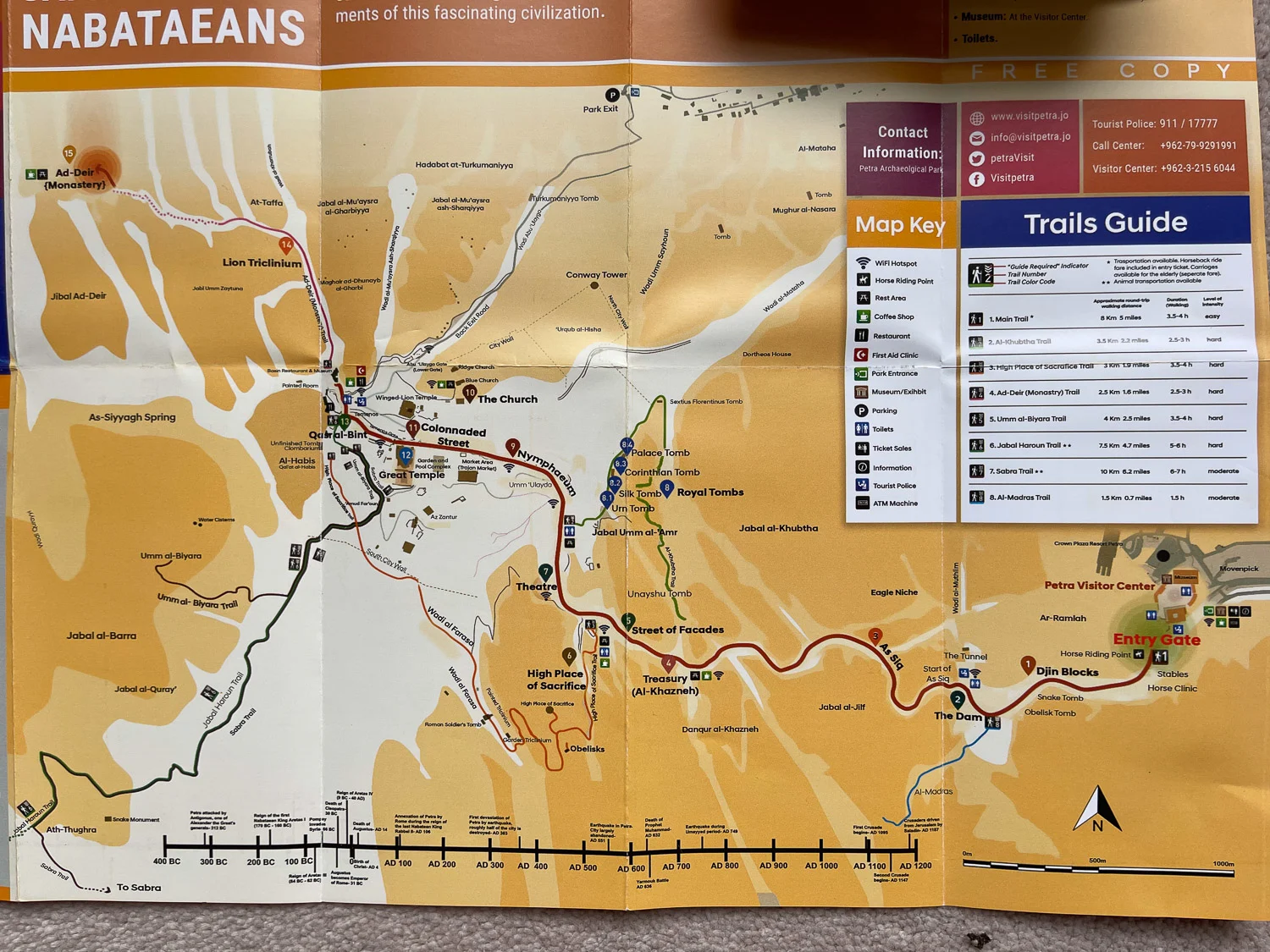
Below is our own map showing locations of the key things to see in Petra,as well as restaurants and toilet locations. There are also numerous stalls selling souvenirs, drinks and snacks, which are too many to mark on the map. For more detail, click on this link or on the map below.
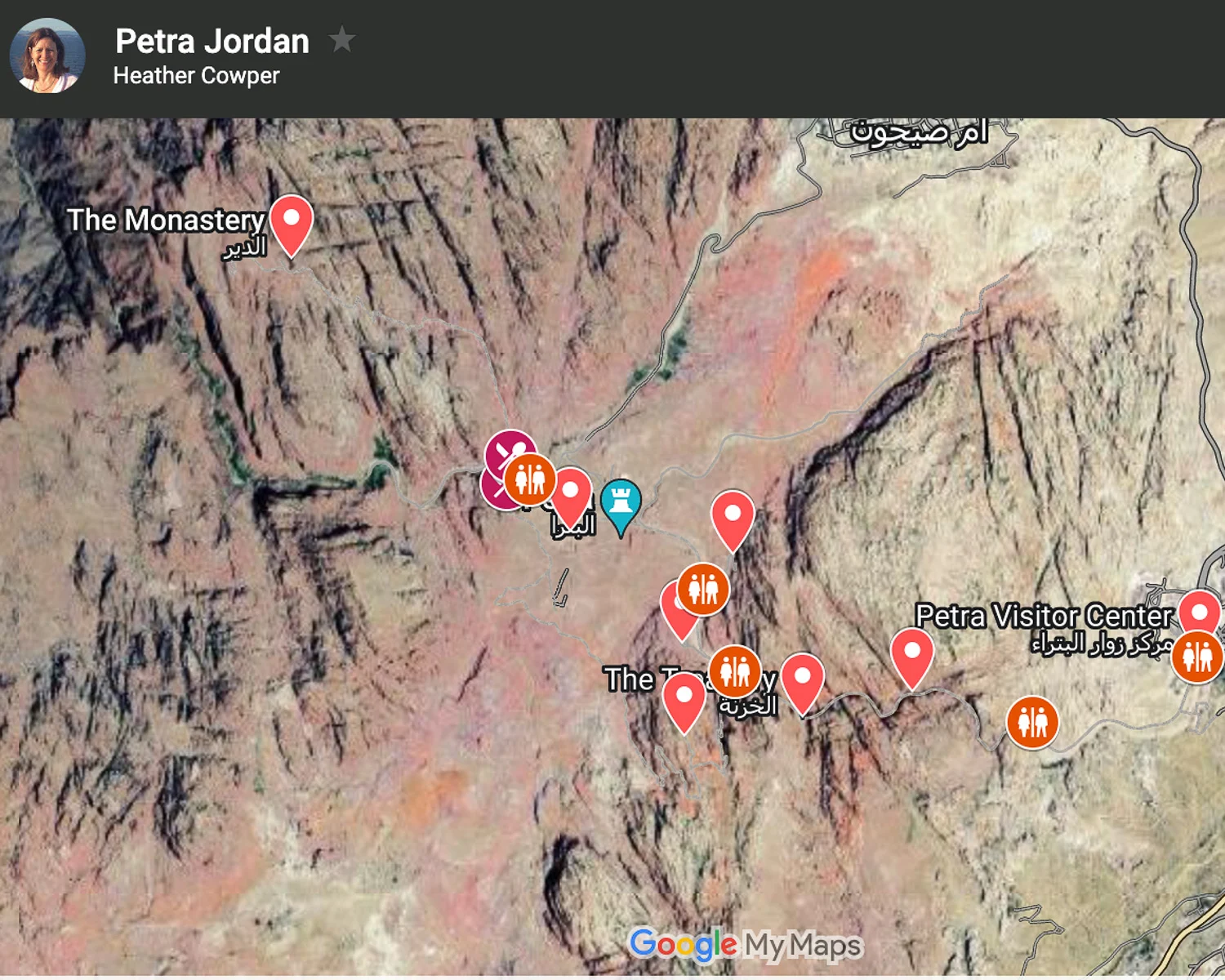
Visiting Petra – more tips for a great visit
In this section of our Petra Guide you’ll find other tips to ensure you have a great visit to Petra, such as what to wear, the facilities available and avoiding common scams.
What to wear for Petra
There are two main considerations about what to wear when visiting Petra. One is respect for the local Muslim culture and the other is the weather conditions.
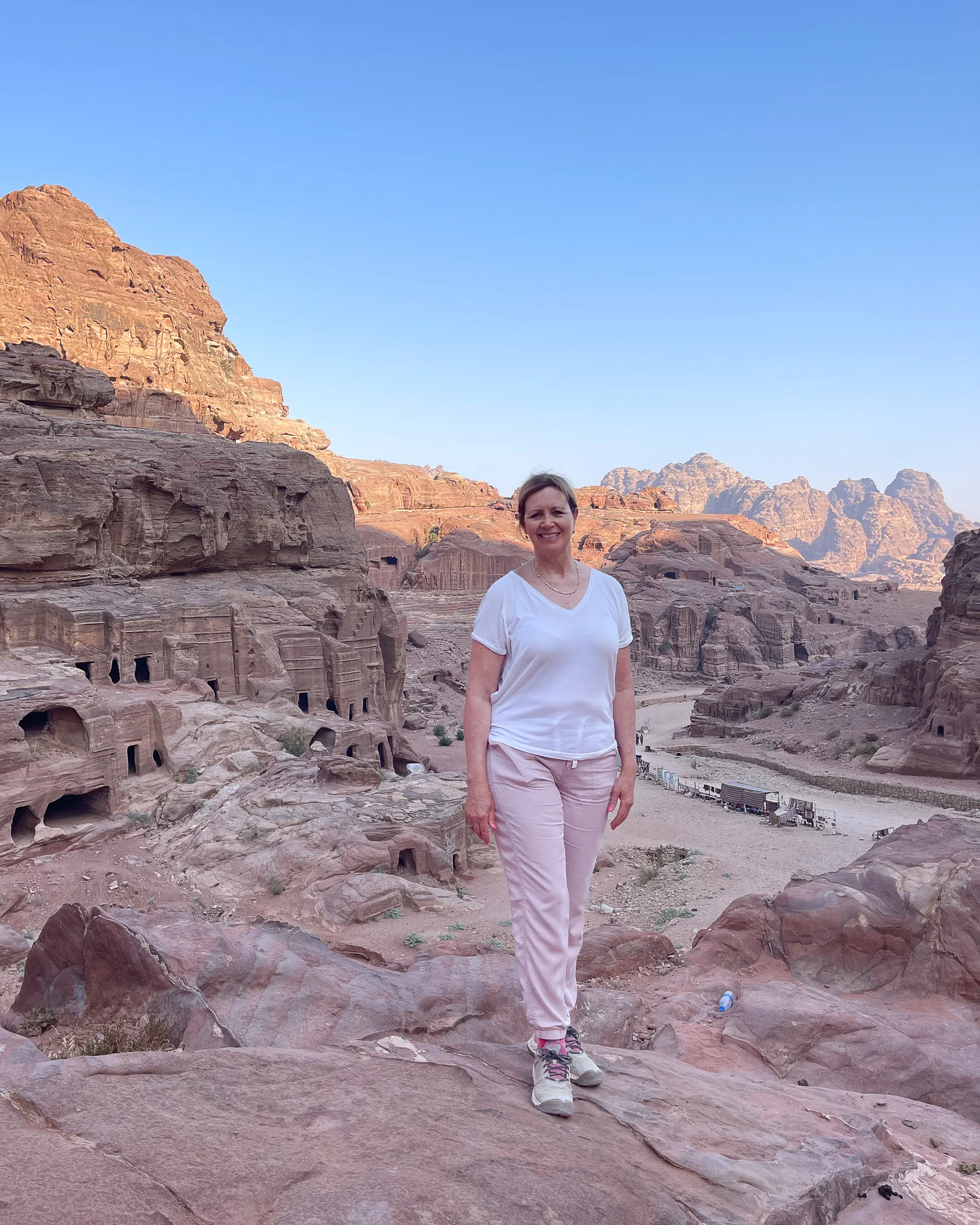
Out of respect for the local Bedouin, it is better for both men and women to cover their shoulders and knees, with no revealing or figure hugging outfits for ladies. Although many local women and men wear a scarf or head covering, it’s not required for visitors to do so, unless you want to shield your head from the sun, dust or rain.
Having said that, Petra is a major tourist attraction and we saw a few people oblivious to the local culture wearing vest tops or short shorts as they would at home. There’s no official who will stop you, but you may get unwanted stares and attention from the young men and teenage boys who ride around trying to sell donkey rides.
If you want to wear long shorts in the burning heat of the summer, that seemed acceptable for men. Most women we saw wore loose long trousers, skirts or cut offs and t-shirts or loose shirts that covered their shoulders.
As Petra is open all year round you’ll also need to dress for the weather, both variable temperatures and potential rain showers. If heavy rain is forecast it’s likely the site will close due to the danger of flash floods.
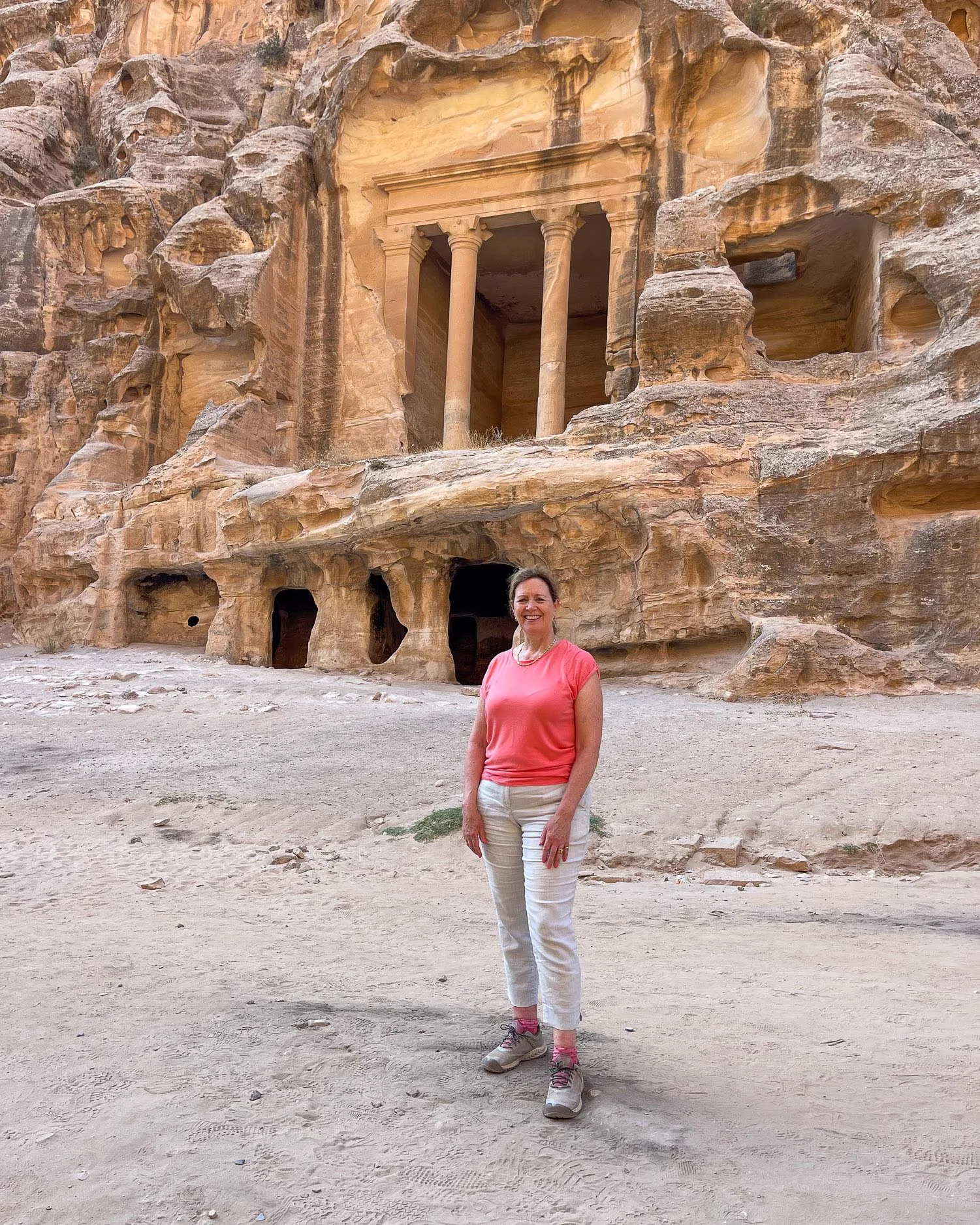
In the desert the temperatures in spring and autumn can vary greatly, from early morning when it’s chilly, to the middle of the day when you’ll only need a t-shirt if the sun’s out. So the best approach is to dress in layers, with a sweatshirt or light jacket and perhaps a scarf, that you can remove as the temperatures rise.
A hat or scarf to cover your head is also recommended as the sun can be quite strong. On sunny days don’t forget your sun screen. The terrain is stony and rough in places, so trainers, walking shoes or hiking sandals are the best footwear.
How to avoid the crowds at Petra?
While spring or autumn offer the most comfortable temperatures to visit Petra, these are also the when the site is most crowded. Here are a few tips to avoid the crowds at Petra.
- Start early when the site opens at 6am. This way you will have walked through the Siq, photographed the Treasury, and moved on to other sites before the main guided groups come through mid morning.
- Stay late or arrive later in the day. The site closes around sunset, at 4pm in winter or 6pm in summer but most of the crowds will have dispersed by mid afternoon.
- Consider taking a break in the middle of the day. This might mean that you return to the visitor centre and rest at your hotel, although it requires a long walk back to the entrance. Perhaps it’s better to find a quiet spot off the main trail to rest and relax with a leisurely picnic.
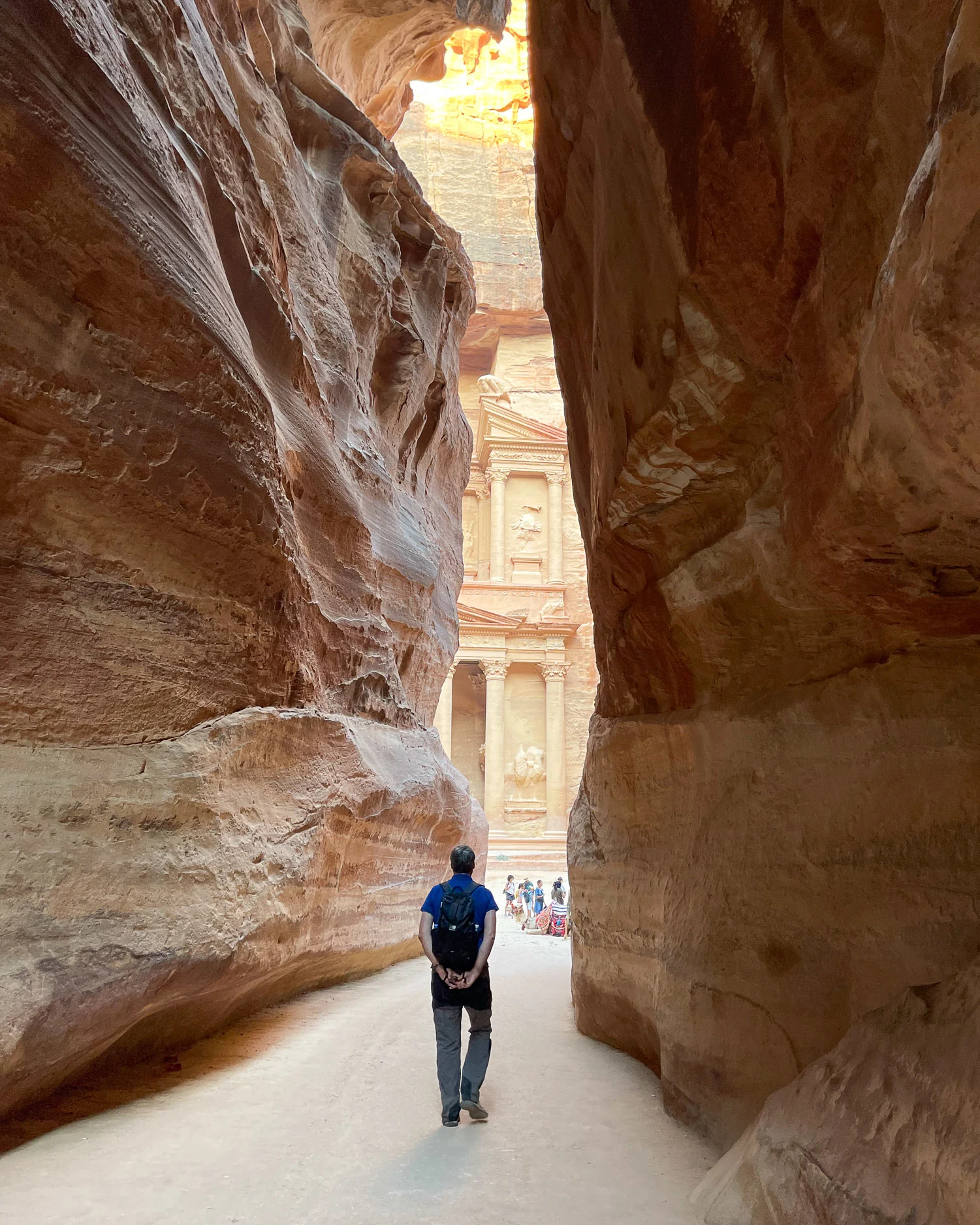
- Get off the main trail by taking one of the hiking routes up the hill, such as up to the High Place of Sacrifice. It’s surprising how few people do and how quickly the crowds thin out.
- On your second day, enter Petra by the “Back Door” as we did for a gentle hike to the Monastery, then descend the 800 steps, going against the flow of the crowds coming up from the valley.
- Visit the site independently, so that you can make your own schedule. While guided tours are convenient for transport, you are likely to be visiting Petra at the busiest time of the day.
Animal rides at Petra
Around the whole site of Petra there are lots of local Bedouin who will offer you a ride on a donkey, horse or camel. It’s possible that on such a big site at Petra, you may be flagging at times and welcome the opportunity to rest and take one of these rides.
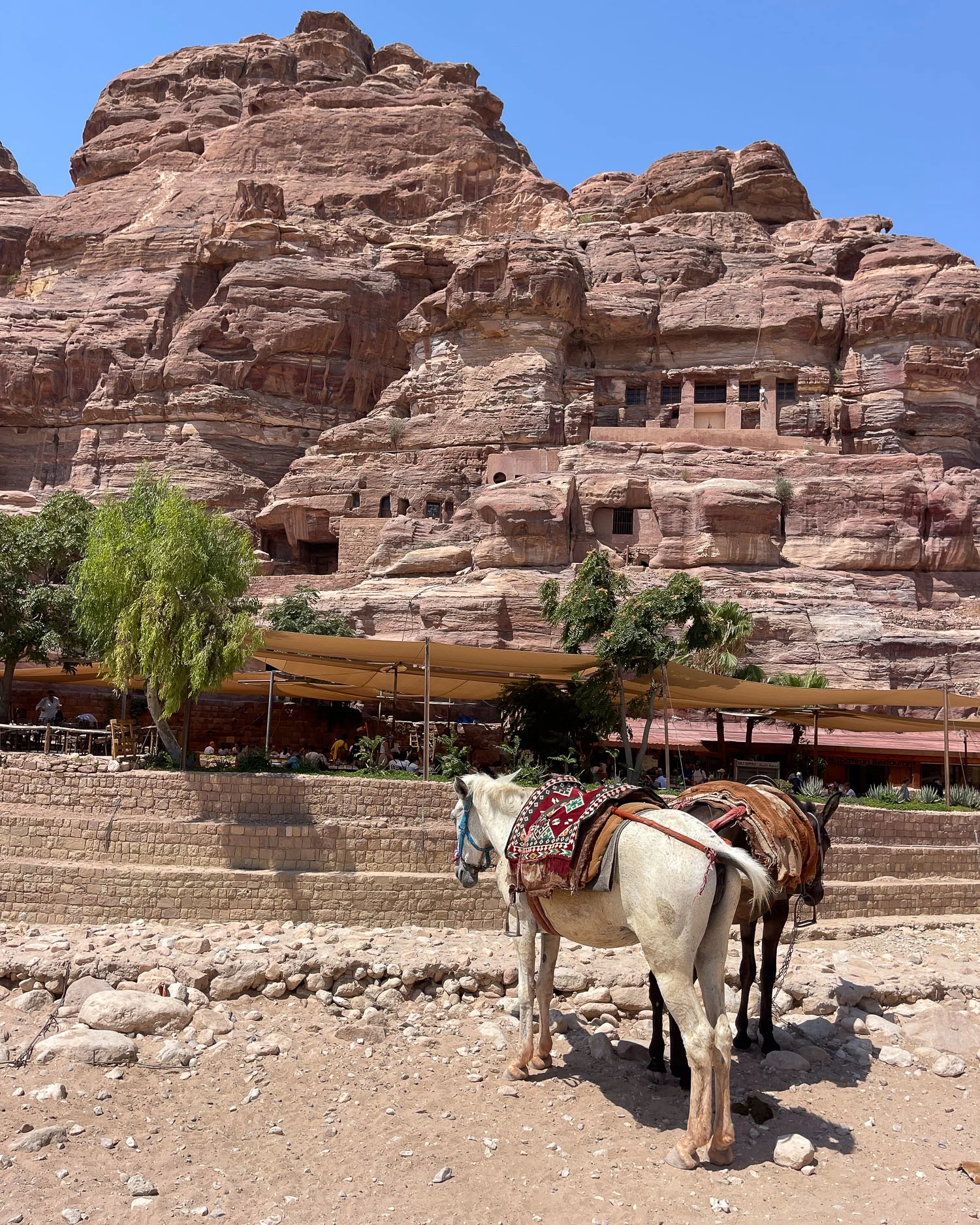
This is one of the main ways that the local Bedouin make money in Petra, but you will read a lot of discussion online about animal welfare and the ethics of animal rides in general. We generally avoid animal rides and didn’t take any in Petra, but if you are considering it, here are a few things to think about:
- If you choose to take an animal ride, try to pick one that looks well cared for. If you see any mistreatment, signal your disapproval to the animal handler or report any major issues at the Visitor Centre.
- Bear in mind that donkeys would traditionally carry goods much lighter than the average western tourist. Carrying heavy travellers up and down steep slopes to the Monastery or other high places in hot weather is exhausting work for them. So maybe it’s OK for children or lighter adults, but if you’re a bit heavier I’d give the donkey a break and walk.
- The routes up to the Monastery, High Place of Sacrifice and trail above the Royal Tombs have steep stone steps, and are narrow with steep drops in places. Going up might feel OK but I think that going down the steep stone steps on a donkey or horse would be quite hair-raising, even the Bedouin do it without a care in the world!
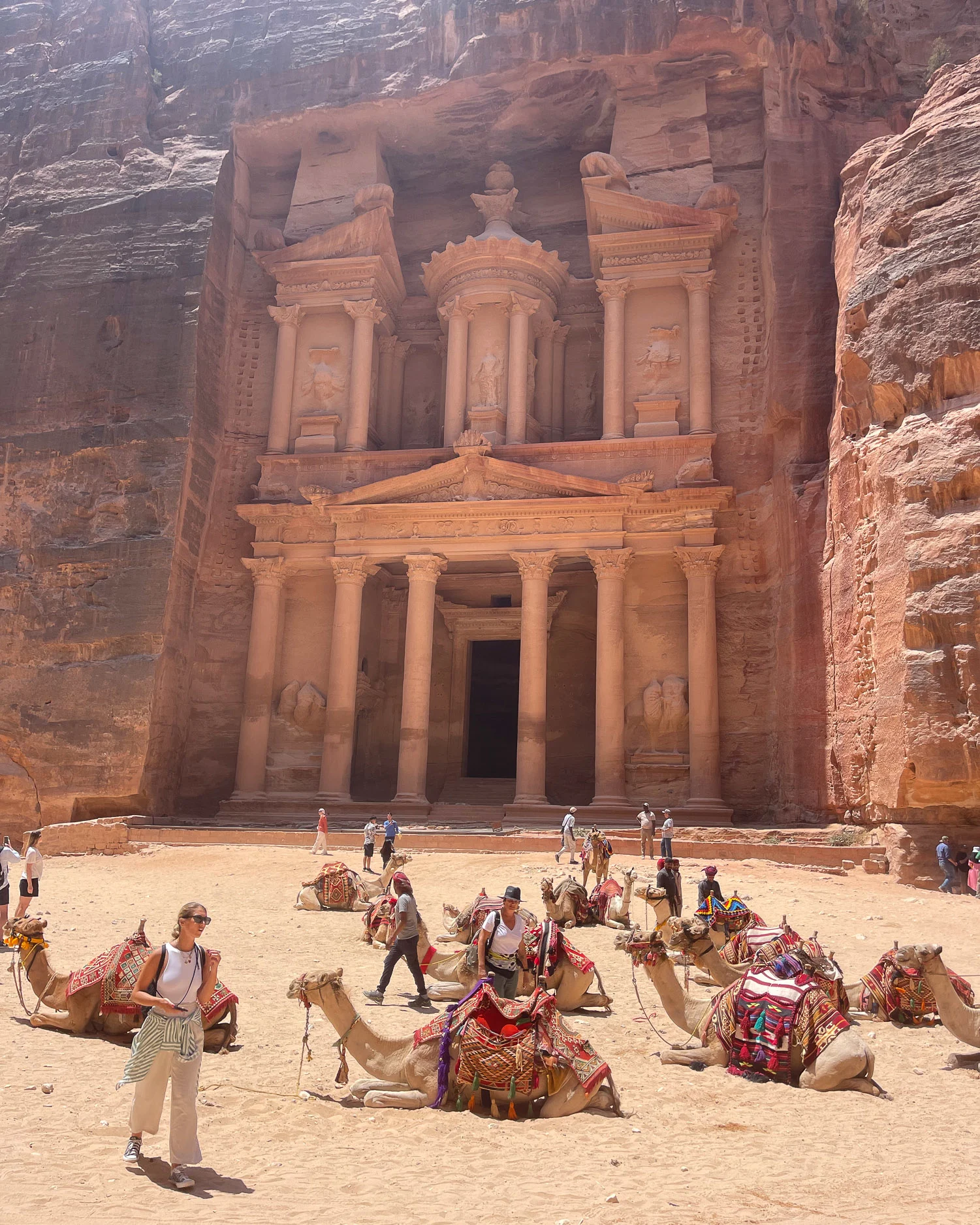
- There are horse drawn carriages that run between the Basin area and Treasury and I feel this would be more acceptable to take a ride at the end of a long and weary day, since the route is relatively flat. You can also order a golf buggy style Club Car to take you from the Visitor Centre to the Treasury and back.
- At the end of the Siq there are horses waiting to take you back to the Visitor Centre. Admittedly, this could be quite an attractive proposition if you are feeling tired at the end of the day. Technically the price of the horse ride is included in your ticket for Petra. However, a mandatory tip is expected (upwards of 5 JD per person) and will be demanded. Therefore it’s best to establish an acceptable tip with the handler before you accept the ride.
- With any animal rides, such as a photograph on a camel in front of the Treasury, it’s best to agree the cost before getting on the animal. We didn’t take any animal rides so I don’t know the going rate, but you can always ask other travellers you see at the end of their ride, or check with a few different animal handlers.
Where to eat in Petra
There are a couple of restaurants to eat within the Petra archaeological site, but many more stalls that will sell you a bottle of water, canned drink, mint tea or fresh orange juice. Bear in mind that due to the nature of the archaeological site, the places that have access to electricity and running water are limited.
As a minimum for your day in Petra, I would pack some snacks and a couple of bottles of water in your bag, especially if you plan to take any of the hikes off the main route. Most hotels offer a packed lunch at a reasonable cost for you to order the night before, which is what we took into Petra.
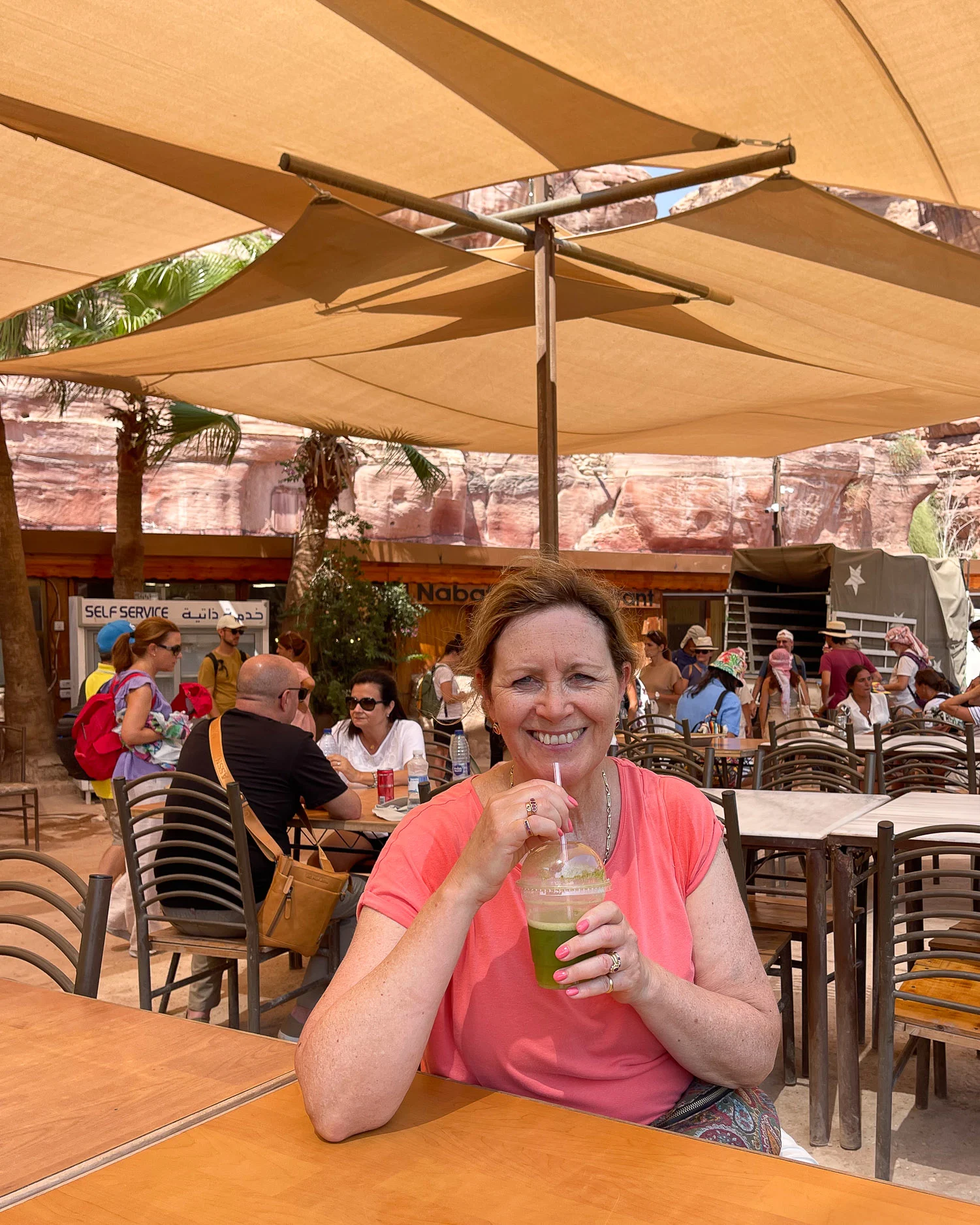
You will find cafes that serve drinks at the Treasury, the path for the High Place of Sacrifice, opposite the Royal Tombs and in the Basin area at the start of the walk up to the Monastery.
Of these the only ones that are proper restaurants, serving a full meal and snacks are the two in the Basin area: The Nabataean restaurant and the Basin restaurant.
In the town of Wadi Musa that serves Petra, there are numerous restaurant options to choose from for your evening meal.
Are there toilets in Petra?
There are public toilets in several places throughout the Petra archaeological site, normally with an attendant who keeps them clean and in good order. Before you enter the site there are toilets in the Visitor Centre, then a portable toilet at the entrance to the Siq.
After seeing the Treasury, there are further public toilets at the turning for the High Place of Sacrifice, opposite the Royal Tombs and in the Basin area before the climb to the Monastery.
At the Monastery we did not see any public toilets but heard that there is a portable toilet. You may need to bring your own toilet paper or give a small tip for the attendant to give you some.
Other facilities in Petra
At most of the places mentioned that have a cluster of cafes and public toilets, there is also a wifi hotspot, although we did not try this out as we had good phone signal for most of the time.
If you have any health issues, it is best to return to the Visitor Centre for help, or there is a First Aid Clinic near the Basin Restaurant.
If you want to stop for a picnic, we did not see any organised picnic areas with tables and benches. However, there are plenty of places to perch on a rock or ledge throughout the site.
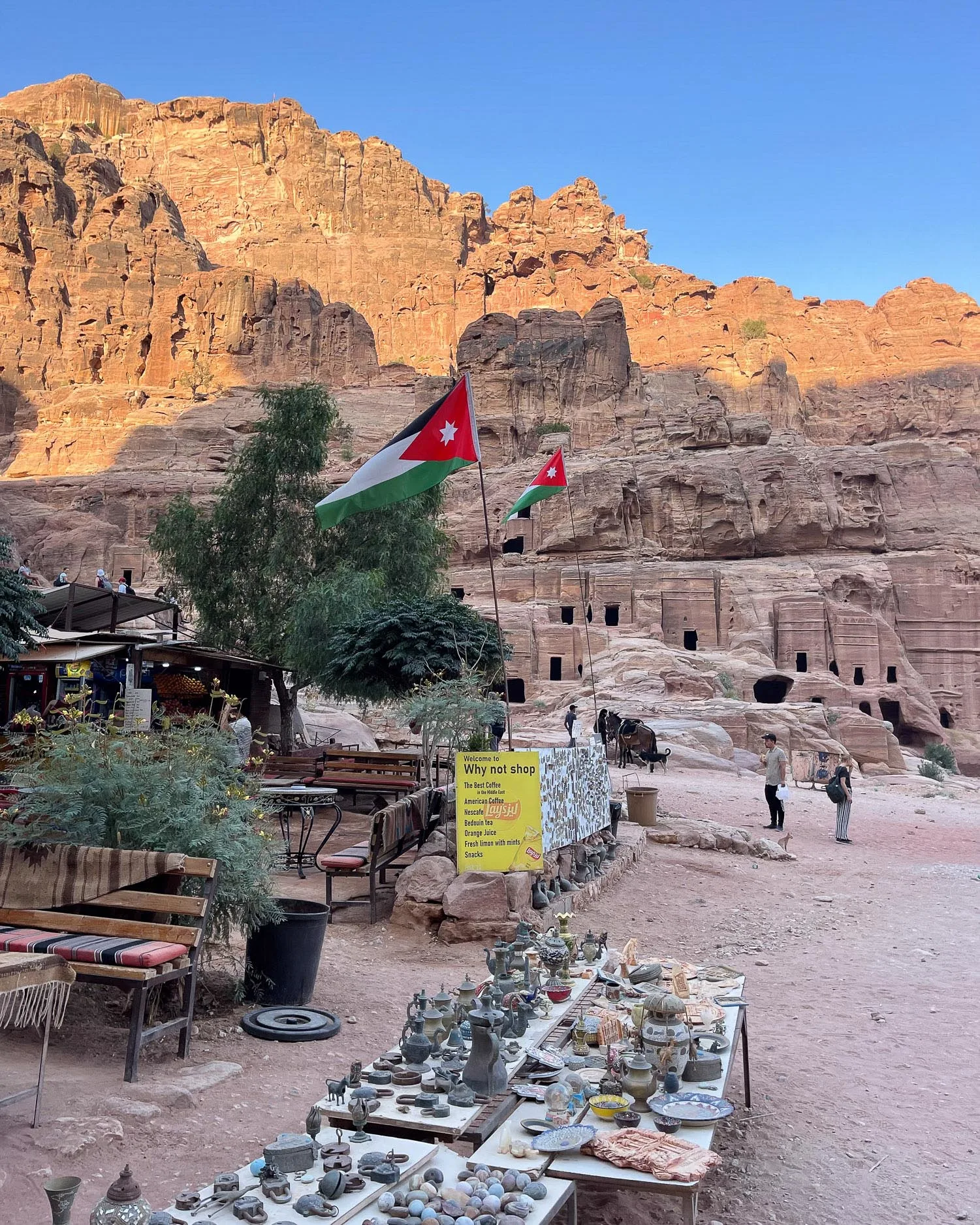
Throughout the whole site are numerous souvenir stalls run by the local Bedouin and if you are ever in doubt of the main path, you can usually tell by the location of the stalls!
Paper maps are available at the Visitor Centre, which give the locations of all the facilities.
Are there guided tours for Petra?
There are many organised group tours that take you to Petra and other key tourist attractions, such as Wadi Rum and the Dead Sea. We didn’t use these ourselves, but could be a good option if you are travelling independently and don’t have your own transport.
3 day tour of Jordan from Amman – This tour includes an overnight stay and visit to Petra. The second night is spent in a desert camp at Wadi Rum, with a visit to the Dead Sea on the way back to Amman.
2 day tour of Jordan from Amman – This tour includes half a day visiting Petra, with an overnight stay and visit Wadi Rum and a quick stop at the Dead Sea.
Petra full day tour from Amman – For those with very limited time, this day trip from Amman is a good option, although bear in mind the drive is 2.5 -3 hours each way, so this will be a long day.
Petra full day tour from Aqaba – This day trip from the Red Sea resort of Aqaba allows for a 3 hour tour of Petra, so you’ll only get to see a few highlights.
Hiring a guide at Petra
Once you arrive at the Petra Visitor Centre, there’s an official guide stand opposite the ticket counters. Here an official guide is available to talk you through the options and answer questions. The prices and trail options are also clearly posted on the wall of the kiosk.
Prices start at 50 JD, for a 3 hour tour with an official guide to explain the history the main sites of Petra. If you are a small group and especially interested in history, this could be a good option. Because there were just two of us, we found it a bit expensive and so relied on the explanations in our guidebook.
Most of the shorter trails around Petra can also be explored independently. However there are some where a guide may be advisable, if they are more remote or you are not a confident hiker. The price of a guide for the different trails varies but as an example a 5 hr trail costs 120 JD or a 6-8 hr trail costs 150 JD.
We personally find that an experienced guide adds a lot to the experience, but for these prices you will get best value if you are a group of 4-6 people.
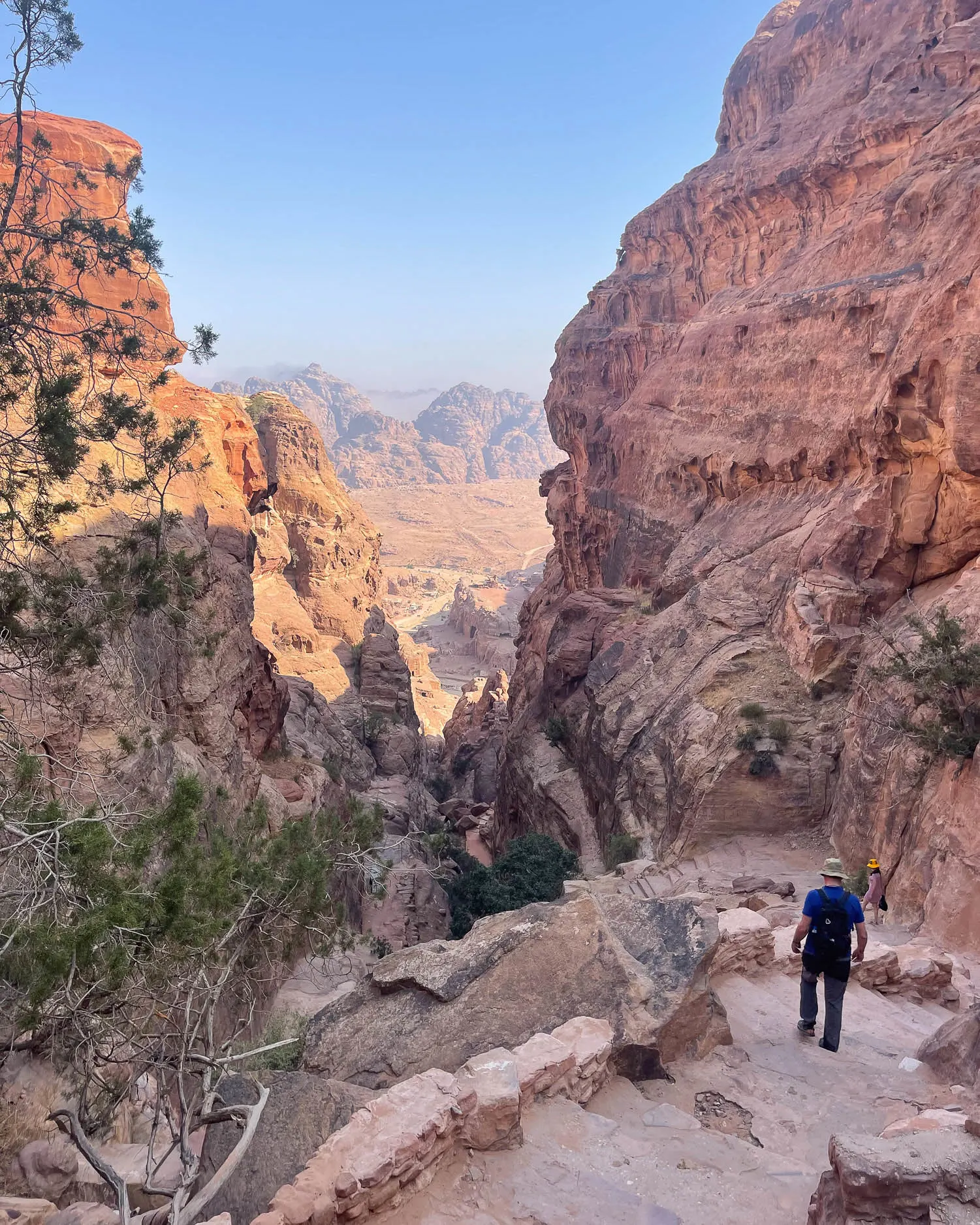
Unofficial guides in Petra
Within the Petra site, it’s possible that you may be approached by local Bedouin offering to guide you. If they don’t have an official guide’s badge, you take these unofficial guides at your own risk, as the cost and quality of service may be variable.
The exception is those who stand in the Treasury area and will offer to take you up to the viewpoint immediately above the Treasury. We didn’t try this, and if you know the way you are probably free to walk up yourself. But if you want to take the most popular social media photo looking down on the Treasury, it may be better to pay a pre-agreed tip to be taken safely to the best spot.
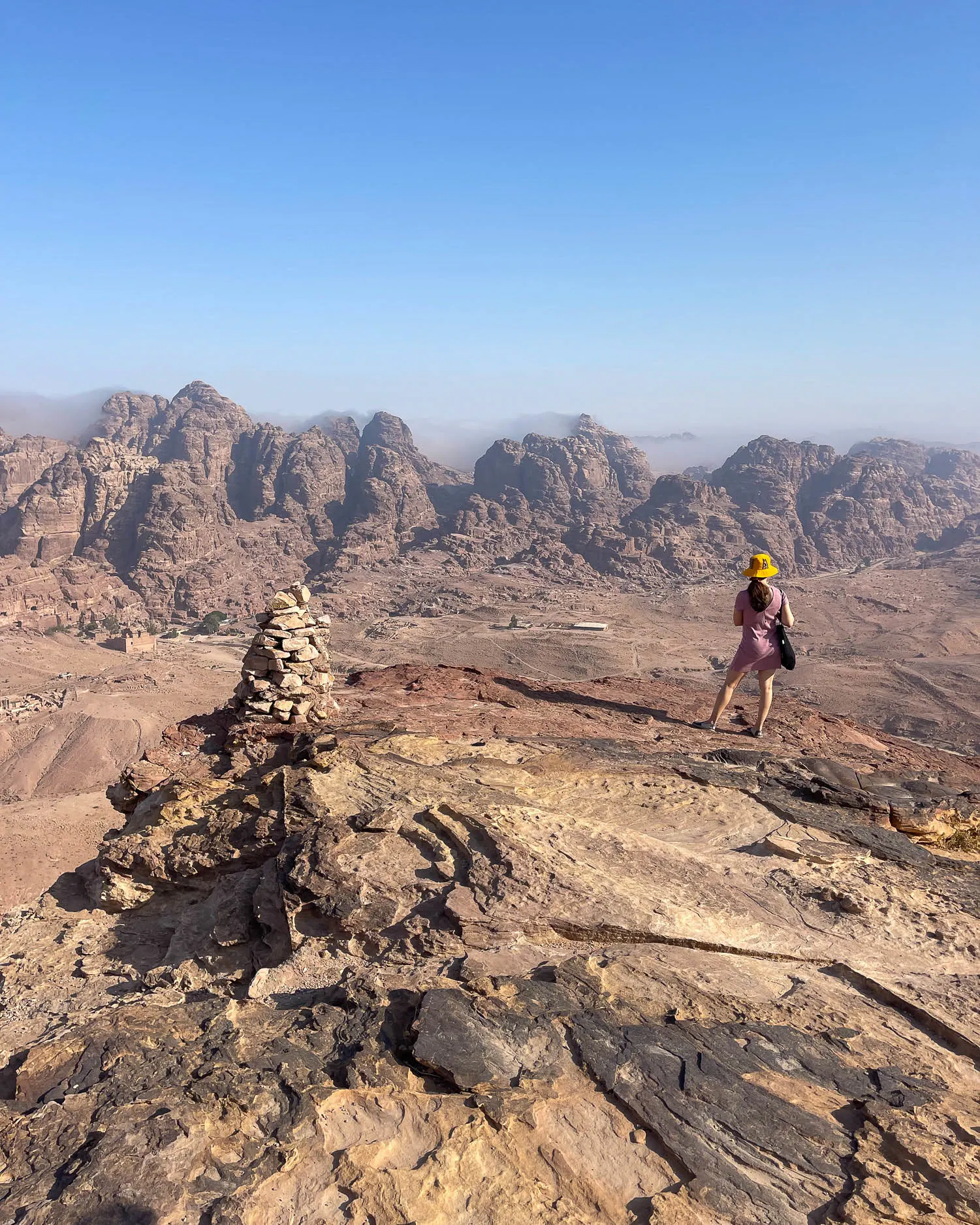
Sustainable travel in Petra
The responsible traveller will want to ensure that such an amazing site as Petra is preserved for generations to come. With this in mind, here are a few tips for an eco-friendly visit.
- While there are rubbish bins in Petra, I personally think it’s better to take all your rubbish out of the site where it can be properly disposed of through your hotel. You should certainly not drop any litter, especially on the less visited hiking trails.
- Plastic water bottles are a big issue, since there is no recycling that we were aware of in Petra. On the one hand I would not recommend drinking tap water in Jordan, in case you get a tummy upset (we did). However if there’s a safe source of filtered water in your hotel, it’s better to fill your bottles there before entering the site. You can also use a water bottle with a built in filter. Another option is to rehydrate on the local beverages of hot mint tea or freshly squeezed orange juice at one of the stalls in Petra.
- Erosion in a desert landscape can be an issue, so if you go on any of the hiking trails, be sure not to wander off the trails which are usually obvious and well marked. Climbing is not allowed due to the risk of rockfalls.
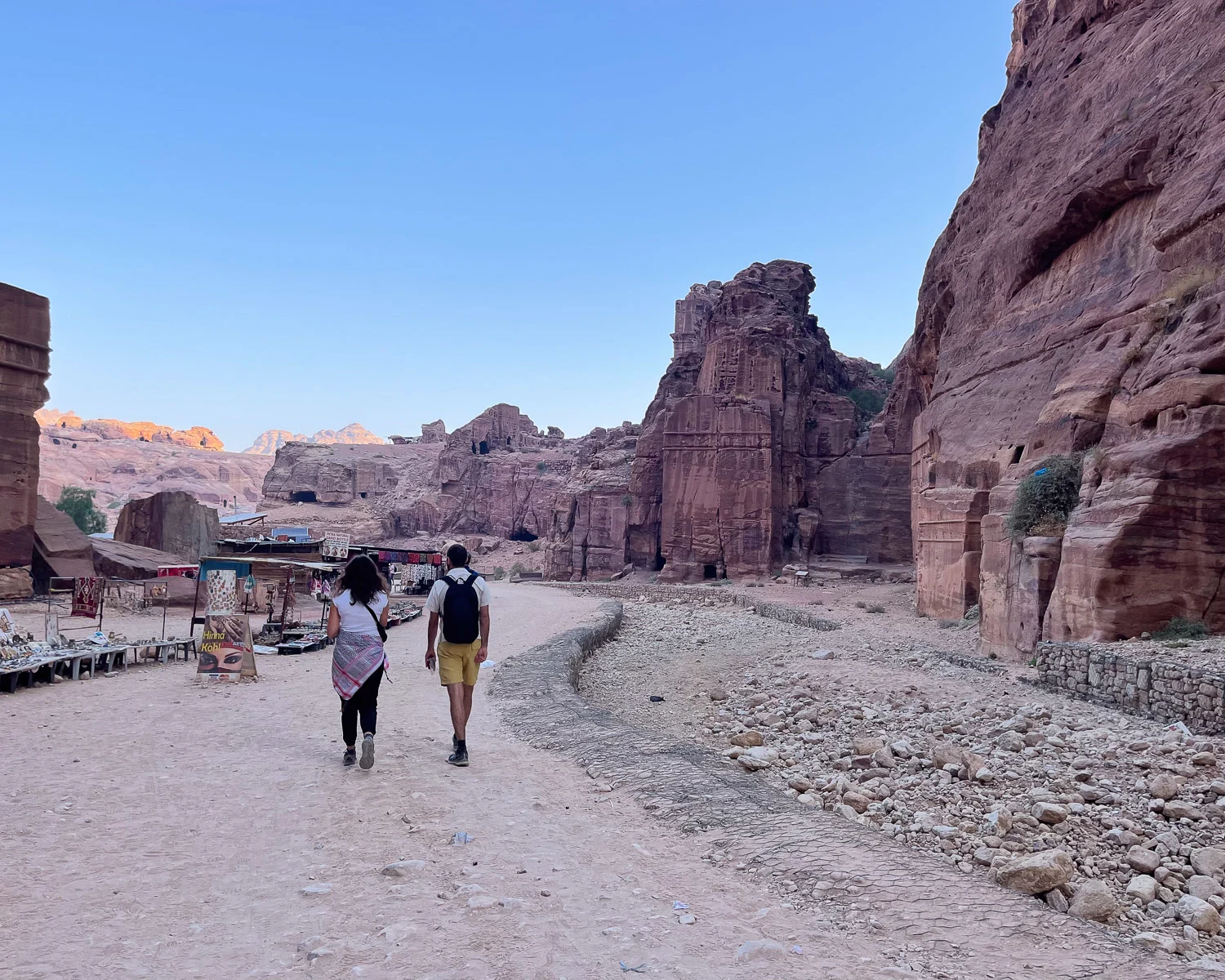
- If you like to buy souvenirs of your trip, try to choose items that are made in Jordan. There are many handicraft projects in Jordan that provide a much needed income for women living in rural communities. We saw many scarves and other souvenirs on sale throughout Petra that did not appear to be locally made. Anything locally made will also normally have a sign to tell you this, or you can ask the stallholders.
- If you choose to hire one of the animal rides in Petra, be mindful of animal welfare and choose an animal that looks well cared for. See my other comments in this article about animal rides.
- There are a lot of teenage or younger boys around the Petra site, generally involved in the family business of animal rides, souvenir shops or cafes. I prefer not to do business at any stalls where I can see children working, if they look as if they should be in school.
- It would be disrespectful to take photos close up of local stallholders and Bedouin around Petra, unless you ask permission first. If there’s someone who is obviously giving a public performance such as playing traditional music, a tip would be expected if you stop and take a photo. If you want to take photos close up of animals such as camels, you should also ask permission and be prepared to tip.
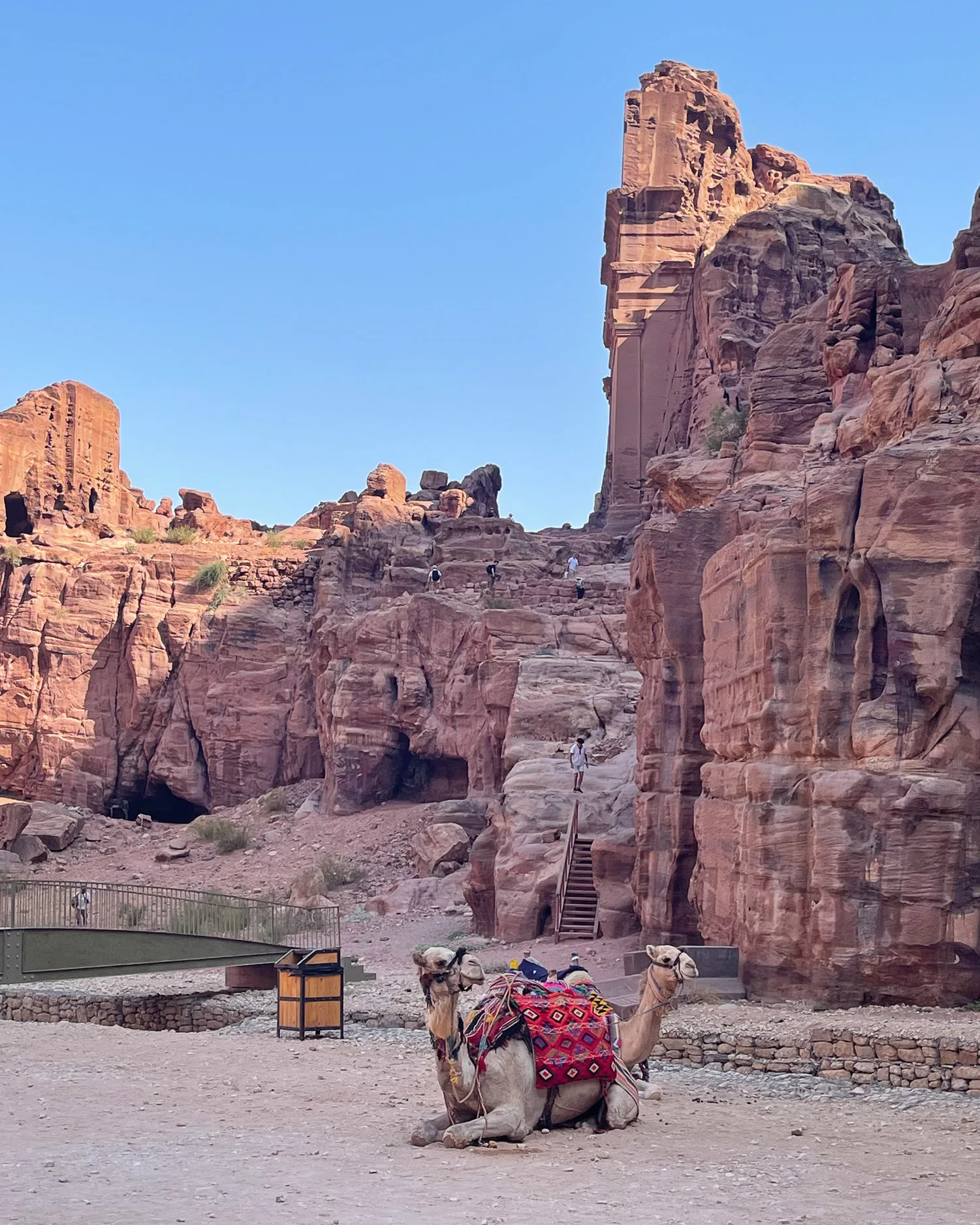
Is Petra safe?
In general we felt very safe at Petra and in Jordan in general, since the country has a very low crime rate. Petra is the country’s flagship tourist site, which is well managed and has tourist police within the site.
Jordan, while a stable country, is unfortunately surrounded by neighbours where conflicts and wars may flare up, so you should always check your Government’s advice on travel in the region.
Here are a few other issues to watch out for.
- The Bedouins running the donkey, horse and camel rides can be very persistent, to the point of nuisance. So if you have no intention of using their service, it’s best not to get into too much banter and walk away politely if they become annoying.
- The animal rides are mostly run by young men, who tend to especially target younger women in conversation, to a point that can verge on harassment. As an older woman accompanied by my husband I didn’t feel it too much but heard other women complaining about it. One way to avoid cultural misunderstandings is to dress and behave in a more modest way. However if you feel you are being harassed as a woman, even after a few polite “no thank yous”, it’s best to avoid further conversation, move into a busy area and gravitate towards an older Muslim woman or other travellers.
- In a culture where bargaining is expected and the price of anything is what you’re prepared to pay, be alert to obvious scams. It’s best to stick to the official guides that can be booked at the visitor centre, as anyone else offering their services within the site may not be qualified. The cost of souvenirs and animal rides is also fluid, but you can cross check typical prices with other travellers.
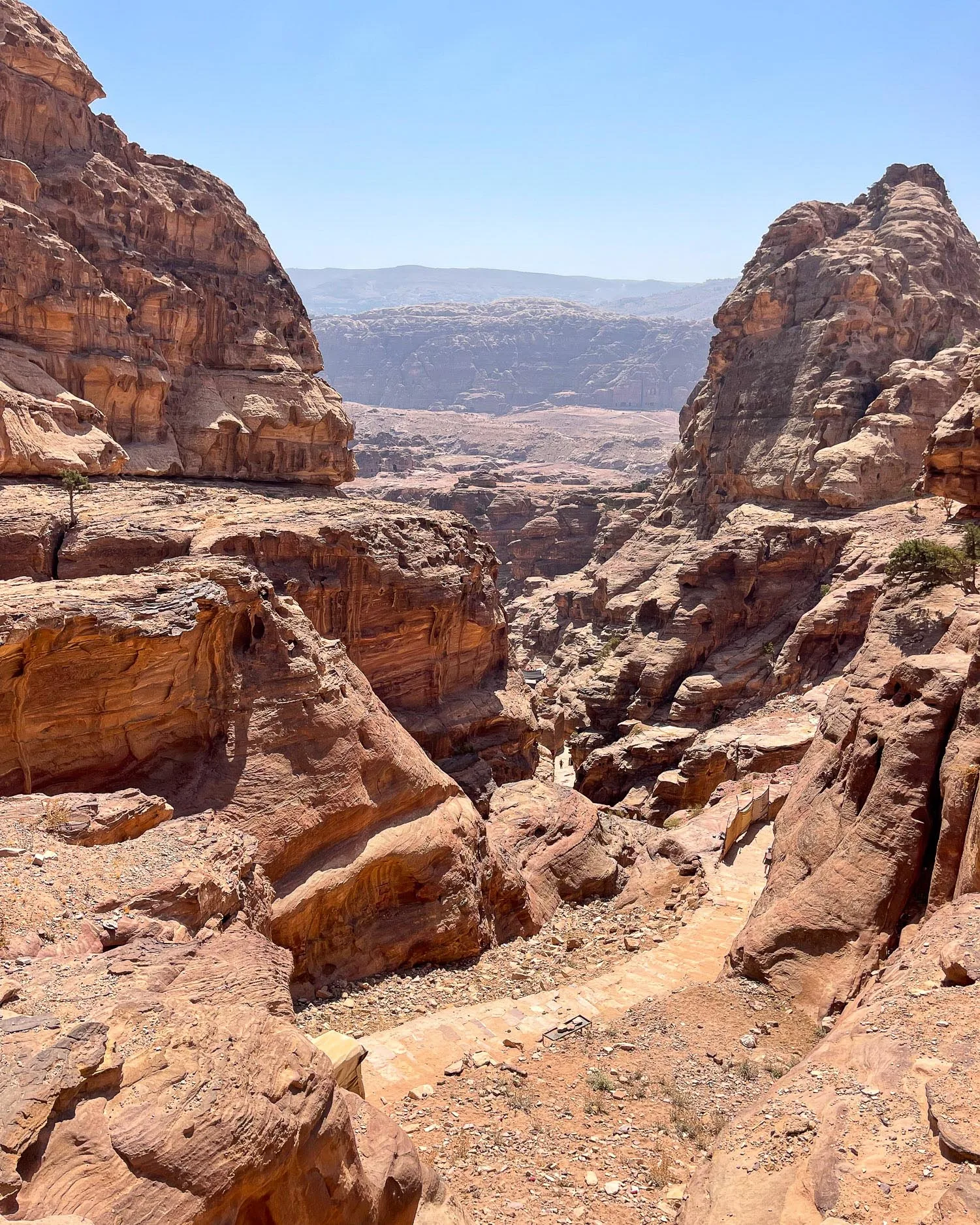
- You should take care of your belongings, as at any crowded tourist site, since pickpocketing is always a risk. Be sure to report any thefts to the tourist police or at the visitor centre.
- As a desert landscape with deep wadis and ravines, Petra has in the past been affected by flash floods after heavy rain. Watch the weather forecast and if rain is due, it’s best to postpone your visit. The authorities are hugely aware of this risk and will close the site if any danger is forseen. However be sure to seek and follow local advice and be aware of the high risk if you get caught in a wadi (dry river bed) during a rainstorm.
- There are many hiking trails up steep paths that may at times have unfenced drops beside them. Be sure to wear appropriate footwear for the stony, rocky and sometimes slippery terrain, taking care on such climbs and descents.
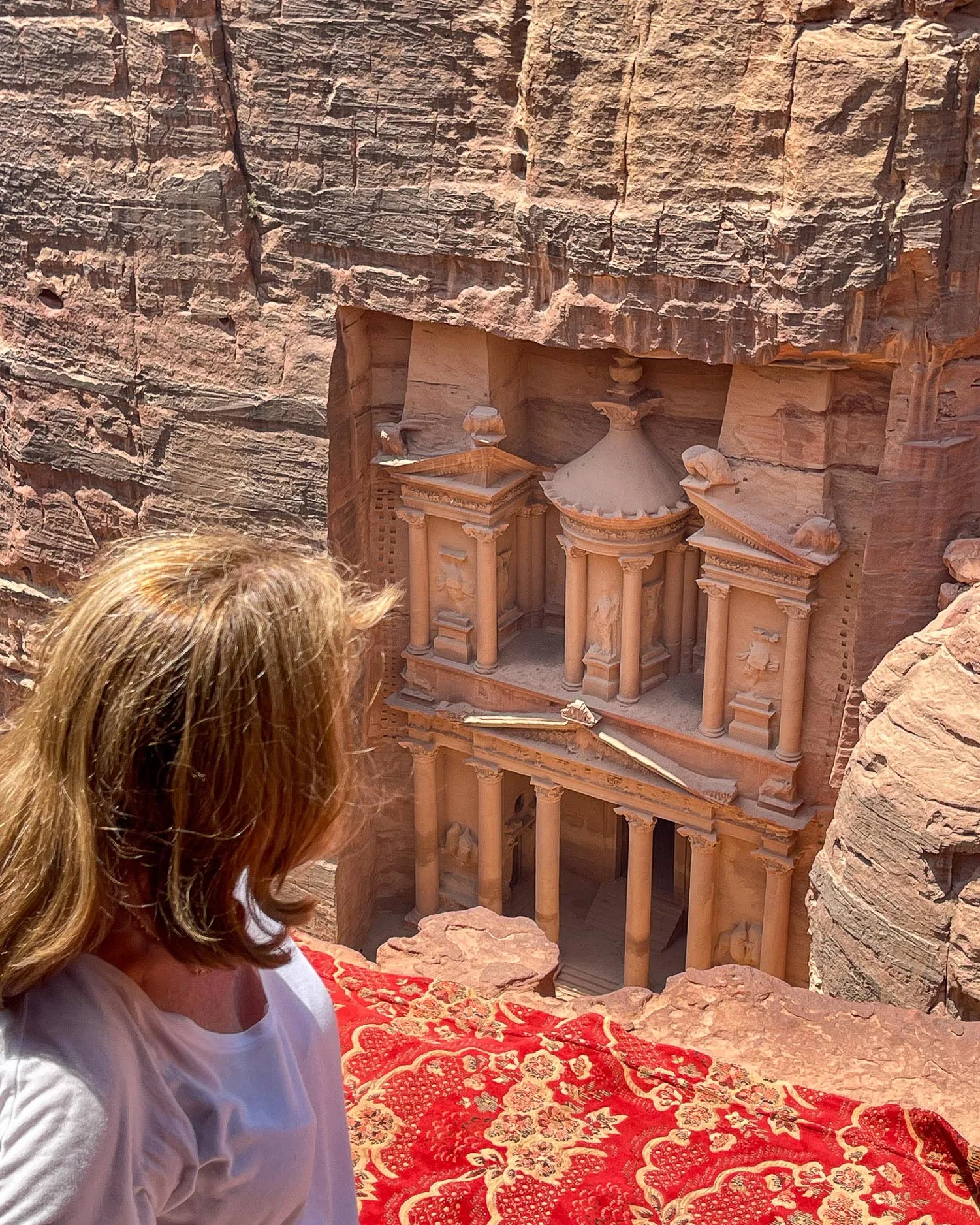
- There are also a couple of viewpoints overlooking the Treasury, where people love to take that stunning social media selfie. I’ve done it myself with caution, but have been shocked how many people are willing to hang off a sheer cliff edge to get the perfect photo!
Recommended hotels for Petra

Esperanza Petra – A good budget hotel with rooftop restaurant in the lower town of Wadi Musa (we stayed here)

Petra Guest House Hotel – A mid range hotel with famous cave bar located next to the Petra Visitor Centre

Mövenpick Resort Petra – A luxury hotel with swimming pool that’s opposite the Petra Visitor Centre
More information to plan your trip
You’ll find more information to plan your trip on the following official tourism websites
- Visit Petra Official Tourism Website
- Visit Jordan Official Tourism Website
- Jordan Pass Official Website
Read Next
Explore the 20 best things to do in Petra Jordan plus itinerary ideas
Guide Book for Jordan
We found it extremely useful to have a guidebook to Jordan. Signage at the top sites like Petra can be limited and hiring a guide can be expensive. We recommend and used the Lonely Planet Guide to Jordan.

Need a guidebook for Jordan? We recommend the Lonely Planet Jordan Travel Guide
You may also enjoy
- Eight things to see in Siwa Oasis in Egypt
- St Anthony’s Monastery of Qozhaya in Lebanon
- Things to do in Casablanca, Morocco – 5 of the best reasons to visit!
Pin it!
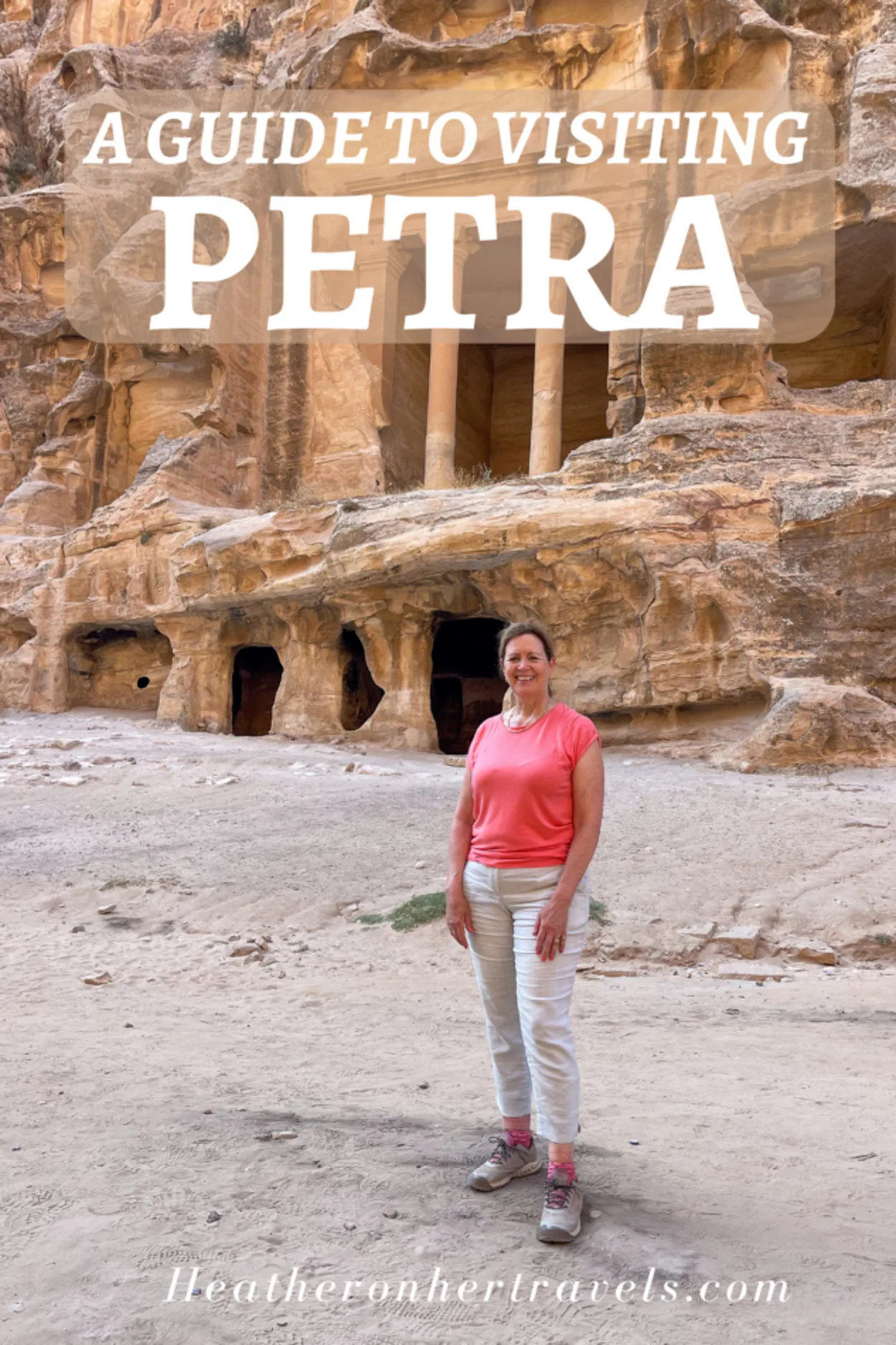
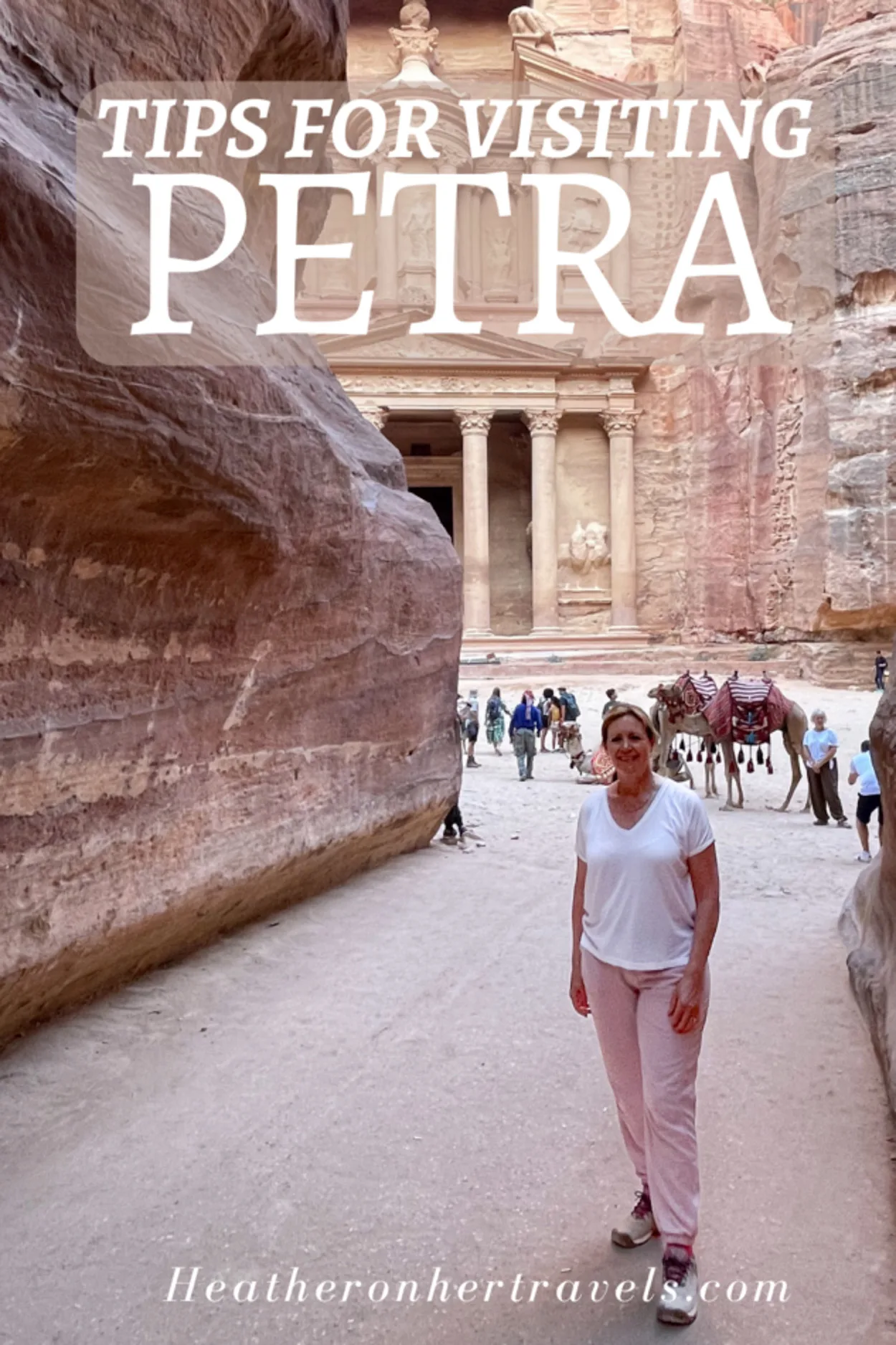
This article is originally published at Heatheronhertravels.com

